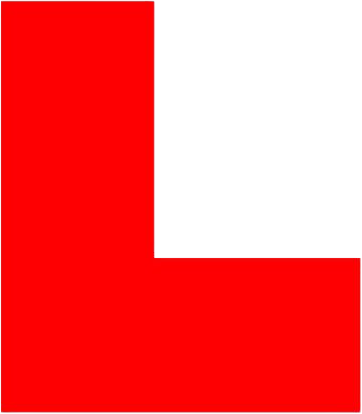ADI Part 1 Theory Test Questions and Answers - Part 2 Traffic Signs and Signals
 The Official DVSA Theory Test for Approved Driving Instructors - DVD-ROM
The Official DVSA Theory Test for Approved Driving Instructors - DVD-ROM
The Official DVSA Theory Test for Approved Driving Instructors - Paperback
This publication is the official DVSA Theory Test book for Approved Driving Instructors. It will prepare you to pass the multiple choice section of your ADI theory test first time. It contains multiple choice questions from the whole theory test question bank, with answers and explanations.
ADI Theory Test Pro- App
This downloadable App works offline and contains every question from the latest DVSA revision question bank and contains Hazard Perception revision videos, licensed by DVSA, and has unlimited mock test questions.
ADI Theory Test 1 Questions and Answers bank - Part 2 Traffic Signs and Signals
1. A bus has stopped at a bus stop ahead of you. What should you do if its right-hand indicator is flashing?
- Flash your headlights and slow down
- Sound your horn and keep going
- Slow down and then sound your horn
- Slow down and give way if it's safe to do so
Explanation: If a bus is signalling to move off, give it priority as long as it's safe to do so. Look for pedestrians who have left the bus and may be trying to cross the road.
2. A driver wants to go ahead at a crossroads controlled by a police officer. What recognised arm signal should they give?

Explanation: The recognised arm signal to a person controlling traffic when going ahead is shown in The Highway Code: use your left hand, held up, with the palm facing forward. This is easily distinguished by the traffic controller and allows them to control the traffic flow efficiently, keeping it moving.
3. A police car is following you. What should you do if the police officer flashes the headlights and points to the left?
- Turn at the next left
- Stop on the left
- Continue your journey
- Move over to the left
Explanation: You must obey signals given by police officers, traffic officers, traffic wardens and signs used by school crossing patrols. When a police officer signals to you to stop, you should stop safely on the left and switch off your engine.
4. Another driver flashes their headlights at you. How should you interpret this signal?
- There's a radar speed trap ahead
- They're giving way to you
- There's something wrong with your vehicle
- They're warning you of their presence
Explanation: A driver flashing their headlights has the same meaning as sounding the horn - it's a warning of their presence.
5. Anti-lock brakes prevent the vehicle’s wheels from locking under heavy braking. What will this help to reduce?
- Skidding
- Over-steering
- Aquaplaning
- Understeering
Explanation: The anti-lock braking system (ABS) activates automatically when the brakes are applied. It prevents the wheels from locking, so reducing the likelihood of a skid developing. ABS doesn't remove the need for good driving practices such as anticipation and driving at the correct speed for the conditions.
6. Apart from pedestrians, what should you be aware of at toucan crossings?
- Trams crossing in front
- Cyclists riding across
- Buses pulling out
- Emergency vehicles emerging
Explanation: Pedestrians and cyclists can both cross at a toucan crossing; cyclists are permitted to ride across.
7. Apart from routine maintenance, when should you check your engine’s oil level?
- When the engine is hot
- Early in the morning
- Before a long journey
- Before carrying a passenger
Explanation: Before setting out on a long journey, check the oil level, as an engine can use more oil on a long journey than on shorter trips. Insufficient oil can lead to excessive wear and engine damage.
8. As a recommendation, how often should you check the brake lights on the car you use?
- Monthly
- Annually
- Daily
- Weekly
Explanation: It's recommended that you check all the lights on your vehicle on a daily basis and replace any faulty bulbs. Carrying spare bulbs and fuses in your vehicle will ensure you can replace a bulb as soon as you find it has failed.
9. As you’re approaching this junction, the green light changes to amber. What should you do if you’re unable to stop at the first white line
- Stop at the second line, in the area marked for cyclists
- Stop as soon as you can and reverse back to the first stop line
- Stop just beyond the second line, keeping the junction clear
- Proceed carefully through the junction, ignoring the second stop line

Explanation: Some junctions have advanced stop lines with an area for cyclists to position themselves ahead of other traffic. You must stop at the first white line you reach. If you're unable to stop safely at the first line, you must stop at the second line, even though you'll be blocking the area reserved for cyclists.
10. At a puffin crossing, which colour traffic light follows the green light?
- Steady amber
- Flashing green
- Steady red
- Flashing amber
Explanation: Puffin crossings have infra-red sensors that detect when pedestrians are crossing and hold the red traffic signal until the crossing is clear. The use of a sensor means there's no flashing amber phase, as there is with a pelican crossing; the lights follow the same sequence as traffic lights.
11. At which type of crossing are cyclists and pedestrians allowed to cross together?
- Pelican
- Zebra
- Toucan
- Puffin
Explanation: A toucan crossing is designed to allow pedestrians and cyclists to cross at the same time. Look out for cyclists approaching the crossing at speed.
12. Can you park on the zigzag lines of a zebra crossing when there are no other parking spaces to be found?
- Yes, if you don't block people from crossing
- No, not under any circumstances
- Yes, in order to drop off a passenger
- No, unless you stay with your car
Explanation: You mustn't park within the area marked by zigzag lines on either side of a pedestrian crossing. You'll be causing an obstruction by obscuring the view of both pedestrians and drivers.
13. Diamond-shaped signs give instructions to drivers of which vehicles?
- Buses
- Lorries
- Trams
- Taxis
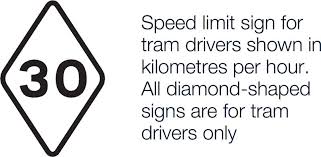
Explanation: Diamond-shaped signs apply to tram drivers. You should know their meaning so that you're aware of the priorities and are able to anticipate the actions of the driver.
14. For the cockpit drill to be effective, some items should be checked before others. What’s the correct sequence?
- Mirrors before seat position
- Seat belt before parking brake
- Doors before parking brake
- Fuel quantity before doors
Explanation: The cockpit drill is a logical sequence of safety checks. New drivers should be trained to go through them methodically and in sequence every time they get into a vehicle. Briefly, these checks are
- doors closed
- parking brake set
- driver's seat position
- head restraint adjusted
- mirrors adjusted
- seat belts fastened
- gear lever in neutral (check parking brake again)
- fuel.
15. Head restraints should be adjusted correctly. What injuries do they protect you from?
- Arm and leg injuries
- Neck and spine injuries
- Hip injuries
- Abdominal injuries
Explanation: Head restraints are provided to protect against neck and spine injuries, commonly referred to as 'whiplash'. They should be correctly adjusted before the start of every journey. An incorrectly adjusted head restraint will offer reduced protection.
16. How can you avoid fuel spillage after you’ve refueled your car?
- Securely fasten the filler cap
- Use a locking filler cap
- Fill the tank to the top, so that no air remains in the tank
- Check your fuel gauge is working
Explanation: Spilled fuel wastes money, damages the environment and makes the road surface slippery. This can be particularly dangerous for motorcyclists. Ensuring that you replace the fuel filler cap securely will prevent fuel spilling from your vehicle's fuel tank.
17. How can you avoid wheel spin when you’re driving on an icy road?
- Brake gently and repeatedly
- Drive at a slow speed, in as high a gear as possible
- Drive in a low gear at all times
- Use the parking brake if the wheels start to slip
Explanation: If you're travelling on an icy road, extra care will be required to avoid loss of control. Keeping your speed down and using the highest gear you can will reduce the risk of the tyres losing their grip on this slippery surface.
18. How can you help the environment and avoid wasting fuel?
- By always using the same brand of fuel
- By keeping an empty roof rack on your car
- By driving with your windows open
- By having your vehicle properly serviced
Explanation: If you don't have your vehicle serviced regularly, the engine will steadily become less efficient. This loss of efficiency will progressively cause an increase in fuel consumption, engine running problems and increased risk of the vehicle breaking down.
19. How can you identify motorway signs?
- They have white letters and figures on a blue background
- They have black letters and figures on a white background
- They have white letters and figures on a green background
- They have white letters and figures on a brown background
Explanation: Most motorway signs have a blue background with white lettering, numbers and borders. These signs not only confirm motorway status but are designed to give clear information to drivers travelling at motorway speeds.
20. How can you modify your driving to help the environment?
- Look and plan further ahead
- Use your car mainly for short journeys
- Accelerate briskly through the gears
- Brake later than normal but without skidding
Explanation: Late braking and harsh acceleration waste fuel. To avoid this, scan and look well ahead so that you can recognise hazards and anticipate problems in good time.
21. How can you tell when you’re driving on black ice?
- Your steering feels light
- It's easier to brake
- The noise from your tyres sounds louder
- You see black ice on the road
Explanation: Black ice makes a road look damp, and you may not be able to see that it's icy. Signs that indicate you may be on black ice include
- your steering suddenly feels light
- a lack of road noise from your tyres.
22. How can you use your vehicle’s engine to help control your speed?
- Change to a higher gear
- Select neutral
- Change to a lower gear
- Select reverse gear
Explanation: Selecting a low gear will help the engine's resistance, known as engine braking, to control your vehicle's speed. This is especially useful when travelling downhill.
23. How do anti-lock brakes help drivers?
- They help drivers keep control when they're accelerating
- They help drivers keep steering control during heavy braking
- They make motorway driving easier
- They allow vehicles to travel faster
Explanation: If the wheels of your vehicle lock, the tyres won't grip the road and then you'll have no control over the steering. The anti-lock braking system will prevent this from happening.
24. How do following vehicles appear in a convex door mirror?
- Travelling faster than they are
- Closer than they are
- Further away than they are
- Larger than they are
Explanation: The outside mirrors fitted to cars are designed to give the driver the best possible view of the traffic behind. To give a wide angle of view, the mirror is made convex, but this makes everything appear smaller and further away than it really is.
25. How does a convex mirror affect the appearance of a following vehicle?
- It makes it look further away than it really is
- It makes it look like it's travelling faster than it really is
- It makes it look closer than it really is
- It makes it look larger than it really is
Explanation: A mirror with convex glass gives a wide field of vision. This makes everything appear smaller and further away than it would look in a flat mirror.
26. How does a puffin crossing operate?
- A sensor holds the lights on amber for traffic while pedestrians are still crossing
- A sensor holds the lights on red for traffic while pedestrians are still crossing
- A sensor holds the lights on flashing amber for traffic while pedestrians are still crossing
- A sensor holds the lights on green for traffic while pedestrians are still crossing
Explanation: At puffin crossings, an infra-red sensor detects when pedestrians are crossing. This controls when the lights change. There's no flashing amber phase as there is with a pelican crossing.
27. How does an anti-lock braking system help you keep control during emergency braking?
- By taking over responsibility for driving
- By allowing you to apply cadence braking
- By preventing the wheels from locking up
- By making the brakes more powerful
Explanation: An anti-lock braking system (ABS) prevents the wheels from locking, so you can continue to steer the vehicle during heavy braking. ABS doesn't replace the need to plan well ahead and brake smoothly and progressively.
28. How does coasting affect a driver’s control of their vehicle?
- It improves the driver's control
- It has no effect on the driver's control
- It makes steering easier
- It reduces the driver's control
Explanation: 'Coasting' is the term used when the clutch is held down or the gear lever is in neutral and the vehicle is allowed to freewheel. This reduces the driver's control of the vehicle because the engine isn't connected to the driven wheels. This removes the assistance of engine braking and the stability of a powered drive train.
29. How is a toucan crossing different from a pelican crossing?
- here's a continuously flashing amber beacon at a toucan crossing
- At a toucan crossing, you only stop if someone is waiting to cross
- There are no road markings at a toucan crossing
- At a toucan crossing, cyclists can cross with pedestrians
Explanation: There are some crossings where cycle routes lead cyclists to cross at the same place as pedestrians. These are called toucan crossings. Always look out for cyclists, as they're likely to be approaching faster than pedestrians.
30. How much more than the normal braking distance should you allow in icy weather?
- Five times the normal distance
- Ten times the normal distance
- Seven times the normal distance
- Twice the normal distance
Explanation: In icy and snowy weather, your stopping distance will be up to 10 times further than in good, dry conditions. To reduce the risk of skidding, take extra care when braking, accelerating and changing direction.
31. How often should tyre pressures be checked?
- At least once a week
- Every time the car is driven
- At least once a month
- Only when the tyres look soft
Explanation: Check all tyres (including the spare) at least once a week. Do it when they're cold and remember to refit the valve caps. The vehicle handbook will tell you if you need different pressures for different conditions. Remember: because it's so dangerous, it's an offence to use a vehicle with an improperly inflated tyre.
32. How often should you check your brake lights are working?
- Before each journey
- After each journey
- Weekly
- Monthly
Explanation: Routine checks, particularly before a long journey, can help to save trouble and expense. Check the operation of all lights, including the brake lights, each time you use the vehicle.
33. How should you apply the footbrake when you’re stopping normally?
- Lightly at first, then by rapid cadence braking
- Progressively and smoothly, easing off the brake as the car comes to a rest
- Gently, well after selecting a low gear
- Sharply, maintaining firm pressure until the car stops
Explanation: Progressive braking is a safe driving technique, which allows other drivers time to react and is more comfortable for your passengers. This will help to prevent skidding, and saves wear on brakes, tyres and suspension.
34. How should you drive on a road where there are road humps?
- Drive slowly at school times only
- Always keep to the maximum legal speed
- Accelerate quickly between each one
- Maintain a reduced speed throughout
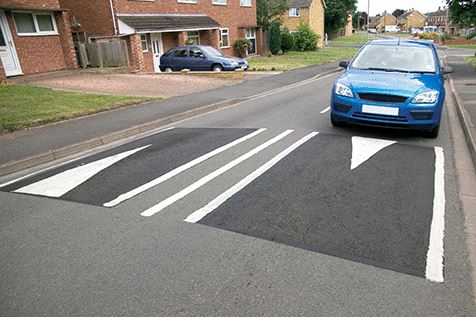
Explanation: Road humps are there to reduce the speed of traffic. Don't accelerate between them, as their purpose is to slow traffic along the whole street. This is to protect vulnerable road users in the area.
35. How will a convex mirror affect the appearance of following vehicles?
- They'll seem to be nearer
- They'll seem to be further away
- They'll seem to be clearer
- They'll seem to be driving faster
Explanation: Exterior mirrors are designed to be convex. This gives a wide angle of view and helps to reduce blind areas. However, a vehicle behind will appear smaller and further away in a convex mirror, so it could be closer than you think.
36. How will a school crossing patrol signal you to stop?
- By displaying a 'stop' sign
- By pointing to children on the opposite pavement
- By giving you an arm signal
- By displaying a red light
Explanation: As you approach a school crossing patrol, you may see two amber lights, one above the other and flashing alternately. This will be accompanied by a 'school' warning sign. The school crossing patrol will display a 'stop' sign, so you must stop. Don't wave anyone across the road, get impatient or rev your engine.
37. How would you recognise signs giving orders?
- They're square
- They're rectangular
- They're triangular
- They're circular
Explanation: There are three main types of traffic sign: those giving orders, those warning and those informing. Signs giving orders are circular, warning signs are triangular, and direction signs are rectangular.
38. If you saw this sign, what would you tell your pupil?
- There's adequate visibility to overtake safely
- Overtaking is prohibited until you see a sign cancelling the restriction
- All traffic ahead is travelling in the same direction
- Overtaking isn't recommended, but it isn't prohibited
Explanation: This sign means it's illegal to overtake. It may have a black-and-white plate telling you over what distance the prohibition applies. There will normally be a sign with an 'End' plate where the prohibition ends.
39. If you saw this sign, what would you tell your pupil?
- There's adequate visibility to overtake safely
- Overtaking is prohibited until you see a sign cancelling the restriction
- All traffic ahead is travelling in the same direction
- Overtaking isn't recommended, but it isn't prohibited

Explanation: This sign means it's illegal to overtake. It may have a black-and-white plate telling you over what distance the prohibition applies. There will normally be a sign with an 'End' plate where the prohibition ends.
40. On a motorway, where would vehicles travelling in opposite directions share the same carriageway?
- In a contraflow system
- On the hard shoulder
- In the acceleration lane
- In a congested section
Explanation: Contraflow systems allow traffic to pass in opposite directions on the same carriageway; they're usually found where roadworks are being carried out. Care is needed as the lanes may be narrower than normal, the road surface may be poor, and oncoming traffic will be passing much closer than normal.
41. On a motorway, where would you see green reflective studs?
- Separating driving lanes
- Between the hard shoulder and the carriageway
- At slip-road entrances and exits
- Between the carriageway and the central reservation
Explanation: At night or in poor visibility, reflective studs in the road help you to judge your position on the carriageway; the colour of the stud will assist you further. Where slip roads join or leave the motorway, green studs are used.
42. Signals are normally given by direction indicators and brake lights. What should drivers do before giving a signal?
- Change gear
- Check the mirrors
- Slow down
- Look all around
Explanation: Before giving any signal, you need to use your mirrors to check what's behind and consider how other drivers may be affected by your signal. Sometimes a signal may not be necessary or you may feel it safer to give a signal earlier or later than normal.
43. The car’s ignition light comes on during a journey. What fault does this indicate?
- The battery needs charging
- The charging system is faulty
- The oil level may be low
- The engine is overheating
Explanation: The ignition light should go out once the engine has started. If it comes on during normal driving, this would indicate a fault with the charging system. Have it checked.
44. The traffic light ahead is showing an amber light. Which colour light(s) will it show next?
- Green and amber together
- Red alone
- Green alone
- Red and amber together
Explanation: At junctions controlled by traffic lights, you must stop and wait behind the white line until the lights change to green. You may then proceed unless your exit road is blocked or it's not safe to do so, such as when pedestrians are crossing in front of you. After the green light, the amber light will show on its own for a short period, followed by the red light. When the amber light shows on its own, you should stop, providing it's safe to do so.
45. There are double white lines in the middle of the road. What does it mean when the line nearest to you is broken?
- You may park on the right
- You may overtake if it's safe to do so
- You may park on the left
- You may overtake, but you mustn't cross the line
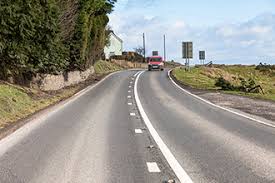
Explanation: Where there are double white lines in the middle of the road and the line nearest to you is broken, you may cross the lines to overtake, provided it's safe and you can complete the manoeuvre before reaching a solid white line on your side.
46. There are no speed-limit signs on the road. What would suggest a 30 mph speed limit?
- Hazard warning lines
- Street lighting
- Double or single yellow lines
- Pedestrian islands
Explanation: There's usually a 30 mph speed limit where street lights are less than 185 metres (600 feet) apart.
47. There’s a ‘give way’ sign where a one-way street joins a main road. What road markings would you see across the mouth of the junction?
- A single broken white line across the whole width of the minor road
- Double broken white lines across the left-hand side of the minor road
- Double broken white lines across the whole width of the minor road
- A single white line across the whole width of the minor road
Explanation: At the end of a one-way street, vehicles turning left will position on the left-hand side of the road and those turning right will use the right-hand side of the road. The double broken 'give way' lines will therefore run across the full width of the junction.
This plate is used with which sign?
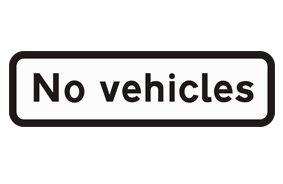

Explanation: The white circular sign with a red border and no symbol means 'no vehicles', including ridden pedal cycles. It's always used with a plate: mostly 'no vehicles', but occasionally 'play street'. Exemptions and times of operation may also be shown on the plate.
48. What advice should you give to a pupil about driving through shallow flood water in a car fitted with manual transmission?
- Drive very slowly in first gear, keeping the engine speed very low
- Drive through as quickly as possible and don't touch the brakes
- Drive through quickly while keeping your left foot on the brake
- Drive very slowly in first gear, keeping the engine speed high
Explanation: When driving through shallow flood water or fords, drive through slowly, in a low gear, while keeping the engine speed high by slipping the clutch; this should prevent water from entering the exhaust system. Check for traffic behind you and, if it's safe to do so, try your brakes as soon as you're clear of the water. Don't attempt to drive through deep or fast-flowing flood water.
49. What advice should you give to a pupil about moving off on snow or ice?
- Use the highest gear you can, with gentle acceleration
- Use the highest gear and keep the engine revs high
- Use the lowest gear you can and accelerate quickly
- Use a low gear and spin the wheels to clear the snow
Explanation: To reduce the risk of wheelspin when moving off on a slippery surface, use a higher gear than normal. This will reduce the amount of torque transmitted to the driven wheels. Gentle use of the accelerator will also make it easier for the tyres to keep their grip.
50. What advice should you give to a pupil who asks whether it’s permitted to drive on the hatch markings?
- You should always position well to the left of the markings
- You can drive on the hatch markings, but only if it's necessary and safe
- You should always wait in this area when you're turning right
- You should never enter the hatched area under any circumstances
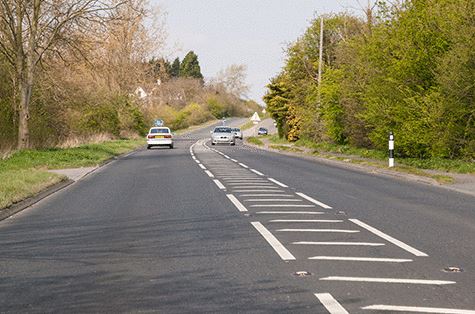
Explanation: Hatch markings are used to separate traffic and to protect traffic turning right. Where the boundary line is broken, you may enter the area only if necessary and provided you can see that it's safe. A continuous white line defining the hatched area means that you mustn't enter, except in an emergency. All other rules of the road apply as normal.
51. What advice should you give to someone who intends to drive a left-hand-drive vehicle in the UK?
- Make full use of the mirrors
- Use hand signals when turning
- Keep well to the left of your lane
- Give signals earlier
Explanation: In a left-hand-drive vehicle, use of the mirrors and awareness of blind areas is very important. Being seated on the car's left makes the blind area on your right more difficult to overcome. For example, when joining a dual carriageway or motorway from a slip road, traffic on the carriageway will be approaching in the blind area on your right and could easily be overlooked.
52. What advice should you give to your pupils about using cruise control?
- Because of new technology, modern cars do not need the driver to be ecosafe
- In the UK, there are no opportunities for learners to drive at a steady cruising speed
- Figures show that the driver is much better than cruise control at keeping to a steady speed
- You could benefit from using cruise control if you can see well ahead and the road conditions are good
Explanation: Many modern cars have cruise control fitted; it automatically maintains a steady speed set by the driver. Setting the cruise control when you can see the road well ahead is clear can help keep fuel consumption down and reduce vehicle emissions.
53. What can cause heavy steering?
- Over-inflated tyres
- Badly worn brakes
- Driving on ice
- Under-inflated tyres
Explanation: If your tyres don't have enough air in them, they'll drag against the surface of the road. This makes the steering feel heavy. As well as affecting steering, under-inflated tyres can affect braking, cornering and fuel consumption.
54. What can you do to help protect the environment?
- Avoid using cruise control
- Drive faster to reduce journey times
- Use your car for very short journeys
- Remove your roof rack when it's unloaded
Explanation: A roof rack increases your car's wind resistance. This will cause an increase in fuel consumption, so you should remove it when it isn't being used.
55. What colour are circular traffic signs that give positive instructions?
- Red and white
- Red
- Blue
- Red and blue
Explanation: Blue circular signs give a positive instruction (for example, turn left) or indicate a route available only to particular classes of traffic, such as buses and cycles.
56. What colour are the reflective studs at the left-hand edge of the motorway?
- Green
- Red
- Amber
- White
Explanation: Reflective studs on the motorway are there to help you in poor visibility. Different colours are used so that you'll know which lane you're in. These are
- red on the left-hand side of the road
- white between lanes
- amber on the right-hand edge of the carriageway
- green between the carriageway and slip roads.
57. What colour are the reflective studs between the lanes on a motorway?
- Red
- White
- Green
- Amber
Explanation: Reflective studs are placed along the edges and between the lanes on motorways. The colour of the stud can help you identify your position on the road when visibility is reduced; for example, when it's foggy. Between the lanes, the studs are white. Red studs are used between the left-hand edge of the carriageway and the hard shoulder. Amber studs are used along the right-hand edge of the carriageway, and green studs are used where slip roads enter or leave the motorway.
58. What colour are the reflective studs where a slip road joins a motorway?
- Amber
- White
- Red
- Green
Explanation: The reflective studs between the carriageway and the hard shoulder are normally red. These change to green where there's a slip road. They help you identify slip roads when visibility is poor or when it's dark.
59. What could happen if you put too much oil in your engine?
- The oil seals may be damaged
- The engine oil will overheat
- The engine will use less oil
- The oil filter will become blocked
Explanation: Too much oil in the engine will create excess pressure and could damage the engine seals and cause oil leaks. Any excess oil should be drained off.
60. What do these white lines along the centre of the road mean?
- No overtaking
- No stopping on the carriageway
- They're lane markings
- There's a hazard ahead

Explanation: Long white lines with short gaps mean there's a hazard ahead. Often a warning sign will show you the nature of the hazard. Don't cross the line unless you can see the road is clear well ahead and you wish to overtake or turn off.
61. What do these signs indicate?
- You're approaching the end of a motorway
- You're approaching the end of a dual carriageway
- You're approaching a concealed depot entrance
- You're approaching a concealed level crossing
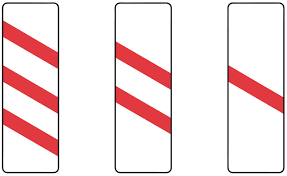
Explanation: If there's a bend or other obstruction concealing a level crossing, you won't be able to see the barriers, signals or any waiting traffic. Countdown markers, spaced equally at about 100 yard intervals, give you an early warning that you're approaching a level crossing, so you can be prepared to stop if necessary.
62. What do zigzag lines at a pedestrian crossing mean?
- Parking allowed only for a short time
- Slow down to 20 mph
- Don't sound the horn
- No parking at any time
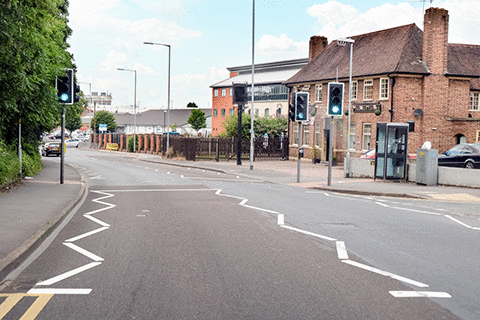
Explanation: The approach to and exit from a pedestrian crossing is marked with zigzag lines. You mustn't park in this area, as it would block the view for pedestrians and traffic. Overtaking the leading vehicle on approach to a crossing is also illegal.
63. What does a differential do when a car is cornering?
- It allows the driven wheels to turn at the same speed
- It allows the inner driven wheel to turn more slowly than the outer wheel
- It allows the driven wheels to rotate in opposite directions
- It allows the outer driven wheel to turn more slowly than the inner wheel
Explanation: The differential mechanism enables the inside wheel to turn at a slower rate than the outer wheel when the car is being driven on a curve. This helps both stability and grip while the car is cornering or turning.
64. What does a red traffic light mean?
- Drivers may go straight on if there's no other traffic
- Drivers must stop behind the white stop line
- Drivers may turn left if it's safe to do so
- Drivers must slow down and prepare to stop if traffic has started to cross
Explanation: You must stop and wait behind the white stop line when the red traffic light is showing. The white line is generally positioned so that pedestrians have room to cross in front of waiting traffic. Don't move off while pedestrians are crossing, even if the lights change to green.
65. What does excessive wear of the central area of tread on a car tyre suggest?
- The wheels are out of alignment
- The tyre has been used over-inflated
- The tyre has been used under-inflated
- The shock absorbers are faulty
Explanation: Over-inflated tyres will cause excessive wear along the centre of the tread. Check your tyre pressures on a regular basis, and when the tyres are cold.
66. What does excessive wear on the outer edges of the tread of a car’s tyre generally indicate?
- The tyre has been used over-inflated
- The tyre has been used at excessive speed
- The tyre has been used on the wrong axle
- The tyre has been used under-inflated
Explanation: If you don't keep your tyres inflated to the recommended pressure, they may wear unevenly. Over-inflated tyres will tend to wear heavily in the centre tread area, while under-inflated tyres will tend to wear more on their outer edges. Check your tyres regularly and use a reliable gauge. Follow the manufacturer's guide for the correct tyre pressure; check and adjust the pressure when the tyres are cold.
67. What does it mean if a bus-lane sign shows no times of operation?
- It's not in operation at all
- It's only in operation at peak times
- It's in operation 24 hours a day
- It's only in operation in daylight hours
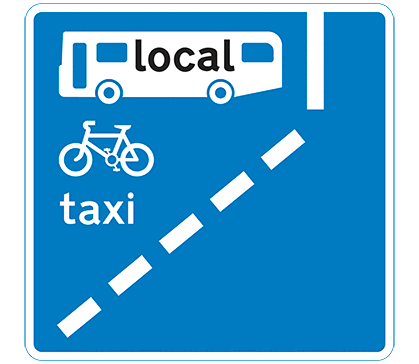
Explanation: You mustn't drive in a bus lane when it's in operation. If the bus-lane sign shows no times of operation, then the lane is in constant operation.
68. What does it mean if you see a vehicle showing a flashing green light?
- The vehicle is being used by a road safety patrol
- The vehicle is being used by a doctor on an emergency call
- The vehicle is being used by the police on non-urgent duties
- The vehicle is being used to carry a wide load
Explanation: If you see a vehicle with a flashing green light, allow it to pass when you can do so safely; it will be a doctor on an emergency call. Someone's life could depend on the driver making good progress through the traffic.
69. What does it mean when the amber light is flashing at a pelican crossing?
- You must wait for the amber light to stop flashing
- You must stop and wait for the green light
- You must give way to pedestrians on the crossing
- You must give way to pedestrians waiting to cross
Explanation: The flashing amber light comes on after the red light, and people may still be crossing. If the crossing is clear and it's safe, you may drive on without waiting for the green light.
70. What does it mean when you see a pedestrian carrying a white stick that has a red band or bands?
- The person has memory problems
- The person is deaf and blind
- The person is a pensioner
- The person is physically disabled
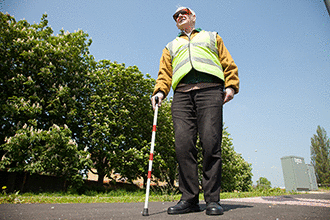
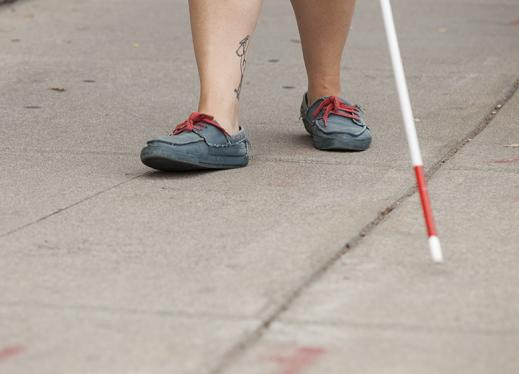
Explanation: If someone is deaf as well as blind, they may be carrying a white stick with a red reflective band. You can't know whether a pedestrian is deaf. Don't assume that everyone can hear you approaching.
71. What does it mean when you see this line along the centre of the road?
- You may now overtake
- There's a hazard ahead
- Oncoming vehicles have priority
- The national speed limit applies

Explanation: A long white line with short gaps means that you're approaching a hazard. Don't cross the line unless you really need to. If you do need to cross the line, make sure that the road ahead is clear before doing so.
72. What does it mean when you see this line along the centre of the road?
- You may now overtake
- There's a hazard ahead
- Oncoming vehicles have priority
- The national speed limit applies
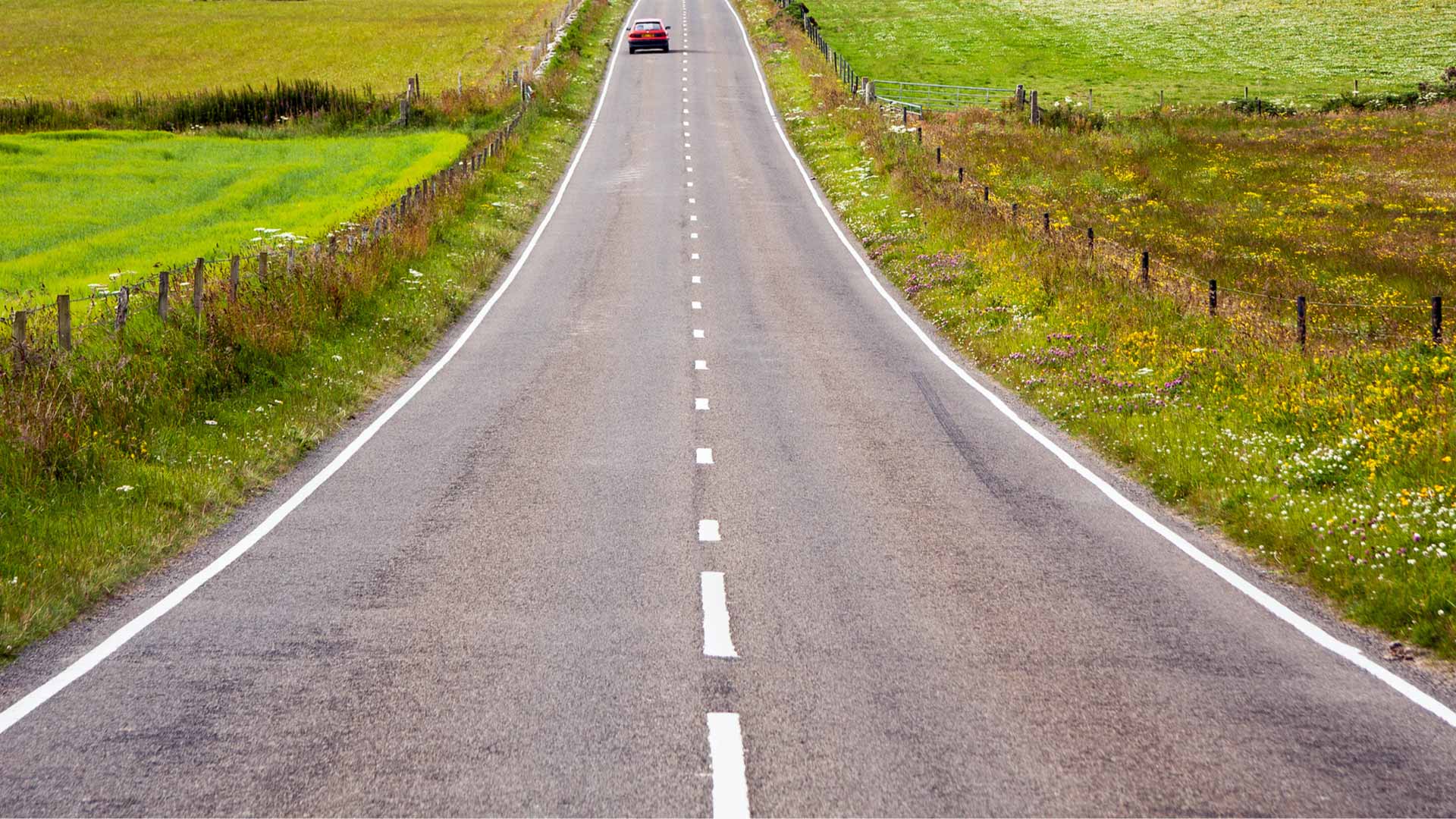
Explanation: A long white line with short gaps means that you're approaching a hazard. Don't cross the line unless you really need to. If you do need to cross the line, make sure that the road ahead is clear before doing so.
Broken White Line: you may change lanes if it is safe to do so
73. What does the continuous white line at the side of the road indicate?
- There are traffic lights ahead
- The footpath on the left
- The edge of the carriageway
- No overtaking

Explanation: A continuous white line is often seen along the edge of the road. Its purpose is to mark the edge of the carriageway. This can be helpful in conditions of poor visibility, such as when it's foggy or at night.
74. What does the curved direction arrow on the road indicate?
- Traffic should turn left ahead
- The lane to follow for your destination
- The direction in which you should pass solid double white lines
- There's a turning place ahead
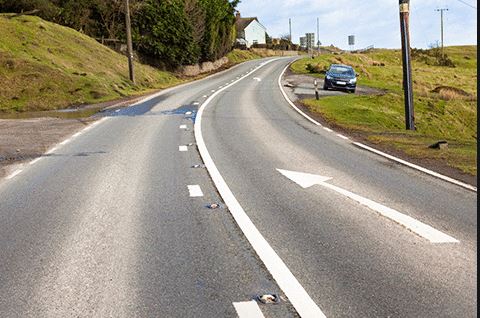
Explanation: Curving direction arrows are often found painted on the road before solid double white lines and hatch markings; they indicate the direction you should pass them. They're also painted on the road on the approach to low arched bridges, to mark the route high vehicles should take.
75. What does the white line along the edge of the road mean?
- It means no overtaking
- It means no parking
- It shows the approach to a hazard
- It shows the edge of the carriageway

Explanation: A continuous white line is used on many roads to indicate the edge of the carriageway. This can be useful when visibility is restricted. The line is discontinued at junctions, lay-bys, and entrances and exits from private drives.
76. What does this sign mean?
- The road bends sharply to the left
- The road goes steeply uphill
- The road is closed further ahead
- The road goes steeply downhill
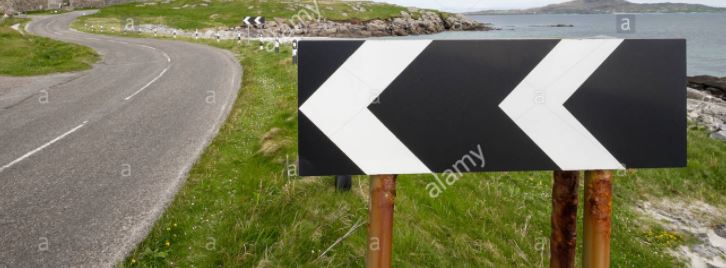
Explanation: A black-and-white chevron sign gives an advance warning to drivers that the road ahead bends sharply in the direction indicated by the chevron. This advance information allows drivers to adjust their speed in good time and select the correct gear for their speed.
77. What does this sign mean?
- There's a 30 mph zone with traffic-calming features
- There's a 30 mph speed limit after the bend
- You're advised not to exceed 30 mph on the bend
- You mustn't exceed 30 mph on the bend
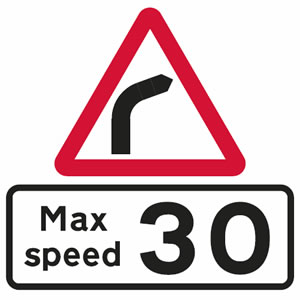
Explanation: The 'max speed' plate advises the maximum safe speed for negotiating the hazard shown on the warning sign. Drivers should slow down, as the hazard can be deceiving; for example, a bend may be much sharper than it initially appears.
78. What does this sign mean?
- Bumpy road
- Loose rocks
- Road flooded
- Loose chippings
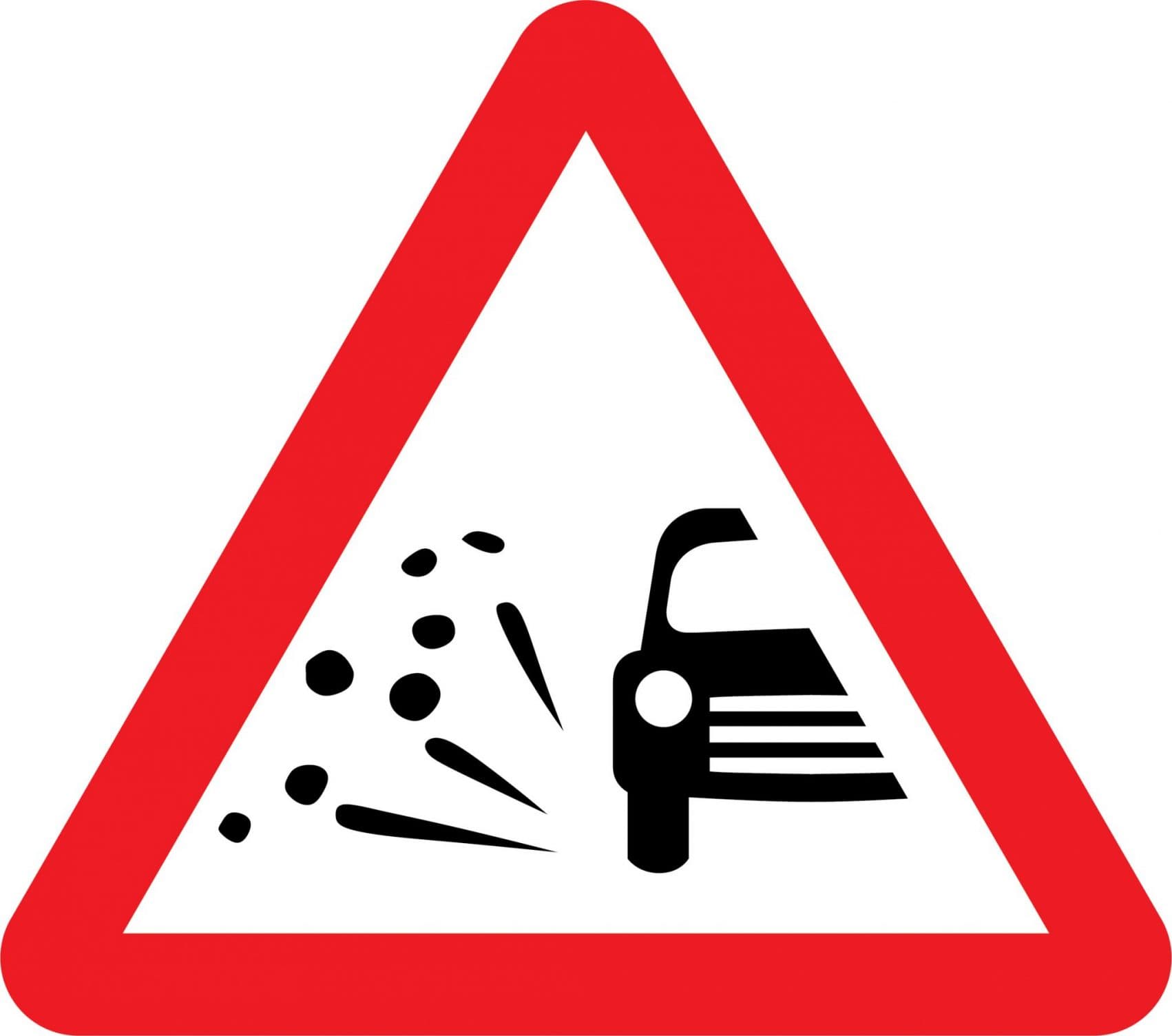
Explanation: The sign warning of loose chippings is often accompanied by a plate showing an advisory maximum speed. Stone chippings thrown up by tyres can damage vehicles, and pedestrians, cyclists and motorcyclists are more vulnerable. The loose surface will increase your vehicle's stopping distance and there's an additional risk of skidding.
79. What does this symbol on a direction sign indicate?
- Emergency diversion route
- Direction to a campsite
- Route for high vehicles only
- Direction to a tourist attraction
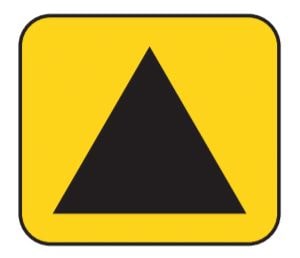
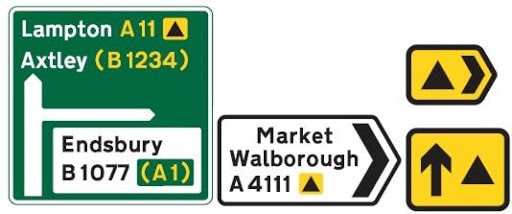
Explanation: Where it's necessary to temporarily close a motorway or other main road, signs will be displayed advising drivers to follow a particular symbol in order to rejoin their route. These symbols are often permanently displayed on direction signs.
80. What does this white arrow on the road mean?
- Overtaking vehicles should return to the left
- All traffic must turn left at the next junction
- The road ahead has a camber to the left
- You may overtake on the left if it's safe to do so
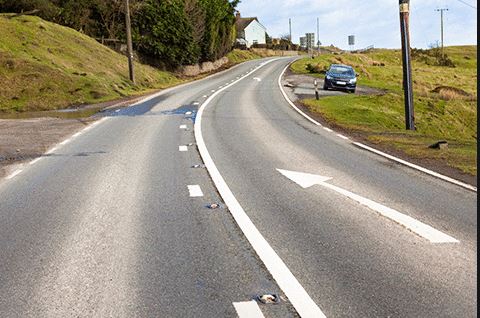
Explanation: This curved arrow on the road indicates the direction that traffic should pass solid double white lines that are coming up. These arrows are also used on the approach to hatch markings and low arched bridges. Sometimes the arrow may curve to the right.
81. What does your vehicle’s catalytic converter reduce?
- Harmful compounds in the exhaust emissions
- How much noise the engine produces
- How long it takes for the engine to warm up
- Damage to the engine caused by using dirty fuel
Explanation: Catalytic converters are exhaust-treatment systems that remove most of the harmful compounds from the exhaust gases. These include carbon monoxide, nitrogen oxides and hydrocarbons. The converter only deals with toxic, polluting gases; carbon dioxide is still produced.
82. What effect does a convex mirror have on the appearance of following vehicles?
- They appear to be closer than they really are
- They appear to be larger than they really are
- They appear to be further away than they really are
- They appear to be moving faster than they really are
Explanation: A mirror with convex glass has a wide field of vision but makes it more difficult to judge the distance and speed of traffic behind. Vehicles seen in this type of mirror appear to be further away than they actually are.
83. What effect will a roof rack have when it’s fitted to your car?
- Your car will handle better
- Your car will be able to go faster
- Your car will use less fuel
- Your car will use more fuel
Explanation: Even an empty roof rack will create extra wind resistance and this in turn will increase the vehicle's fuel consumption; for this reason, remove a roof rack when it's not needed.
84. What fault would you suspect if the footbrake on your car starts to feel spongy?
- The hydraulic system contains air
- The wrong brake pads are fitted
- The brake discs are worn
- The brake pads are worn
Explanation: If air gets into the hydraulic system, the brake pedal will feel spongy. When you press it, the air is compressed, causing the pedal to move further than normal. As a result, braking efficiency is reduced. Have the system checked by a qualified mechanic: brake faults are too important to be ignored.
85. What happens if your vehicle starts to aquaplane?
- You lose control of the washers and wipers
- You lose control of the steering and brakes
- You lose control of the brakes only
- You lose control of the steering only
Explanation: If you drive too fast in wet conditions, your steering may suddenly feel 'light'. This indicates that the tyres have lifted off the surface of the road and are skating on the surface of the water. This is known as aquaplaning. While this is happening, you'll be unable to steer the vehicle and your brakes will have no effect on your speed. To restore your tyres' grip on the road, ease off the accelerator smoothly. Don't brake or turn the steering until tyre grip has been restored.
86. What happens in a controlled zone?
- Speed is controlled by traffic-calming measures
- Waiting restrictions are normally indicated by yellow time plates
- Cyclists have priority over motor vehicles
- Waiting restrictions are normally indicated by yellow lines only
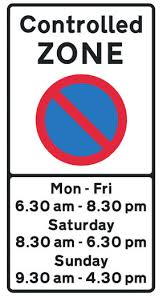
Explanation: The entry sign to a controlled parking zone will show the times of operation. Inside the zone, yellow lines indicate where waiting is prohibited. Yellow time plates are provided where a yellow-line restriction operates at different times from those shown on the entry sign.
87. What instruction should you give a pupil about controlling the vehicle’s speed when going down a long, steep hill?
- Pump the footbrake to prevent the brakes from overheating
- Switch the engine off and coast to save fuel
- Engage the highest gear to keep the engine revs as low as possible
- Use a combination of a lower gear and the footbrake
Explanation: Using a lower gear will allow the engine braking to assist the brakes in keeping the vehicle's speed under control. Avoid coasting with the clutch held down or rolling in neutral, as there will then be no engine braking.
88. What is known to cause excessive or uneven tyre wear?
- Having the wheels out of alignment
- A damaged exhaust system
- The type of gearbox
- Gentle use of the accelerator
Explanation: If your tyres show uneven or excessive wear, have the alignment checked. This is often called tracking, and it can be carried out by most garages or tyre-fitting businesses.
89. What liquid should you use to top up your battery?
- Distilled water
- Tap water
- Diluted anti-freeze
- Battery acid
Explanation: The level of electrolyte in a battery may fall below the level of the plates. If this happens, you'll need to top up the electrolyte with distilled water. Make sure that the plates in each battery cell are covered, but don't overfill the cells.
90. What must a driver do at a pelican crossing when the amber light is flashing?
- Wait for the red-and-amber light before proceeding
- Give way to any pedestrians on the crossing
- Always wait for the green light before proceeding
- Signal the pedestrian to cross
Explanation: The flashing amber light allows pedestrians who are already on the crossing to get to the other side before the green light shows to traffic. Give way to them and only proceed when the crossing is clear.
91. What must you do to any load that you carry on a roof rack?
- Make it as light as possible
- Fasten it securely
- Cover it with plastic sheeting
- Remove it when you park on the side of the road
Explanation: You're responsible for making sure that anything you carry on your vehicle is fastened securely. The safest way to carry items on the roof is in a specially designed roof box. This will help to keep luggage secure and dry. Roof boxes also have less wind resistance than exposed loads carried on a roof rack, and this helps to reduce fuel consumption.
92. What plate would you normally find with this sign?
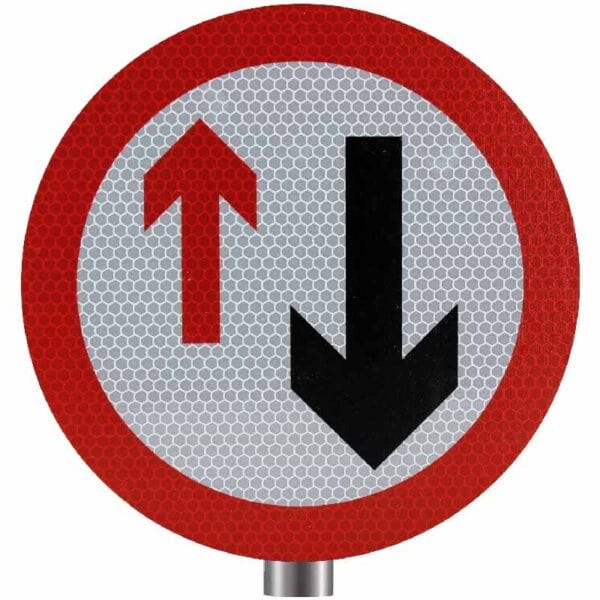
- Priority over oncoming vehicles
- Give way to oncoming vehicles
- Hidden dip
- For 2 miles

Explanation: The sign means 'Give way to oncoming vehicles', and it will be used where the road narrows; for example, where traffic-calming build-outs reduce the road width. It should not be confused with the blue rectangular sign that gives priority in the other direction.
93. Do you know the difference between these two signs?
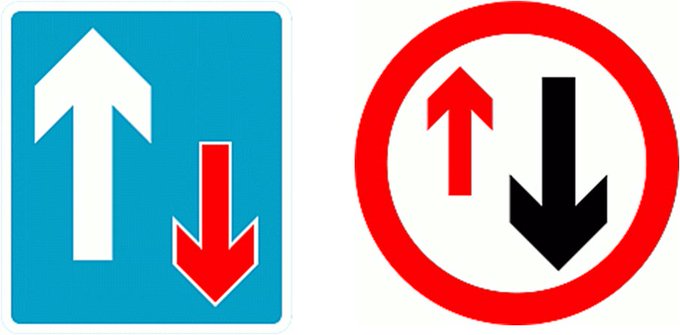
Both signs refer to traffic with priority. The first one indicates that traffic travelling in this direction has priority over oncoming vehicles. The second sign means you must give way to oncoming vehicles.
94. What shape is a ‘give way’ sign?
- Square
- Circular
- Triangular
- Octagonal
Explanation: All warning signs are triangular, but the 'give way' sign is the only triangular sign that points downwards; this is to give it greater prominence as you approach a junction. When you see this sign, you must give way to traffic on the road that you're about to join.
95. What shape is a ‘stop’ sign at a junction?
- Circular
- Octagonal
- Triangular
- Rectangular
Explanation: To make it easy to recognise, the 'stop' sign is the only sign that's octagonal. The visibility from a junction where the 'stop' sign is used will be poor, even from the edge of the junction. You must stop and, if necessary, edge forward until you can see it's safe to drive out.
96. What should you advise your pupil to do when they see this sign?
- Proceed past the sign, as only buses and cycles are prohibited from using the route
- Choose another route, as the road ahead is for buses and cycles only
- Avoid stopping on the road ahead, as parking places are provided for buses and cycles only
- Keep right, as the left-hand side of the road ahead is for buses and cycles only
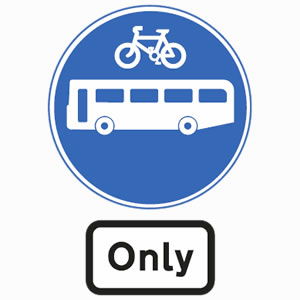
Explanation: This blue circular sign indicates a route available only to the class of vehicle shown. Plan ahead so that when you see the sign, you have time to take another route; this may be indicated by other traffic signs.
97. What should you be aware of when you see this sign?
- An overgrown ditch or soft verge alongside the road
- There may be oncoming vehicles out of sight
- Possible flooding or deep water at a ford
- A sudden change in the road surface condition
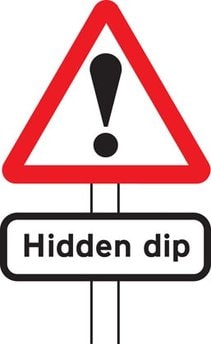
Explanation: Where there's a hidden dip (dead ground), you should be aware that there could be oncoming vehicles out of sight between you and the road in the distance. Don't start to overtake until you can see into the dip and know the road ahead is clear.
98. What should you do if a dashboard warning light comes on while you’re driving?
- Deal with the problem when there's more time
- Hope that it's just a temporary electrical fault
- Check out the problem quickly and safely
- Continue if the engine sounds all right
Explanation: Make sure you know what the different warning lights mean. An illuminated warning light could mean that your car is unsafe to drive. Don't take risks. If you're not sure about the problem, get a qualified mechanic to check it.
99. What should you do if a tyre bursts while you’re driving?
- Brake sharply and steer to the right
- Brake firmly and steer to the left
- Hold the steering wheel firmly and let the car stop gradually
- Change gear and relax your grip on the steering wheel
Explanation: Try not to panic if a tyre bursts while you're driving. Take your foot off the accelerator and avoid braking suddenly. Try to steer a straight course while holding the wheel firmly.
100. What should you do if the warning light for your anti-lock brakes stays on?
- Check that the parking brake is released
- Have the brakes checked immediately
- Check the footbrake free play
- Check the brake-fluid level

Explanation: If any warning light shows while you're driving, it indicates a fault that needs prompt attention. If the warning light for the Anti-lock Brake System (ABS) shows, have the braking system checked before driving further.
101. What should you do if there are flashing amber lights under a school warning sign?
- Reduce speed until you're clear of the area
- Increase your speed to clear the area quickly
- Keep up your speed and sound the horn
- Wait at the lights until they change to green
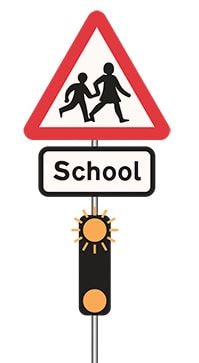
Explanation: The flashing amber lights are switched on to warn you that children may be crossing near a school. Slow down and take extra care, as you may have to stop.
102. What should you do if you discover that the coolant in the vehicle radiator needs topping up during a long journey?
- Keep driving, as the fan will cool the engine
- Keep the engine running and fill it with coolant immediately
- Hose down the engine to cool it before refilling
- Let it cool before removing the filler cap
Explanation: You should check the coolant level frequently, particularly before a long journey, and top it up as necessary. The need to top up often might indicate a leak or other fault in the cooling system. Have it checked by your garage or dealer.
103. What should you do if you have to stop your vehicle in an emergency?
- Select reverse gear
- Keep both hands on the wheel
- Apply the parking brake and footbrake together
- Give an arm signal
Explanation: If you find yourself having to stop in an emergency, it's important that your vehicle remains under control. If you lose control, you may make the situation worse. Having both hands on the wheel during braking will help you to control the steering as you stop.
104. What should you do if you see two elderly pedestrians about to cross the road ahead?
- Expect them to wait for you to pass
- Speed up to get past them quickly
- Stop and wave them across the road
- Be careful; they may misjudge your speed
Explanation: Elderly people may misjudge how far away you are and how fast you're travelling. This may cause them to step into the road when you would expect a pedestrian to wait. They may also walk slowly and so could take a long time to cross the road.
105. What should you do if your vehicle has a fire in the engine compartment?
- Remove the coolant cap
- Remove the oil cap
- Open the bonnet and put out the flames
- Call the fire service
Explanation: If your vehicle catches fire, quickly get the occupants out of the vehicle and to a safe place. Don't attempt to put out a fire in the engine compartment. Opening the bonnet will give the fire more oxygen and make it flare up. Call the fire service.
106. What should you do if your vehicle pulls to one side when you’re braking?
- Pump the pedal when braking
- Change the tyres around
- Consult your garage as soon as possible
- Use your parking brake at the same time
Explanation: The brakes on your vehicle must be effective and properly adjusted. If your vehicle pulls to one side when braking, take it to be checked by a qualified mechanic. Don't take risks.
107. What should you do if you’re driving behind a cyclist who’s giving a right turn signal?
- Squeeze past the cyclist on the left-hand side
- Overtake before the cyclist gets to the junction
- Flash your headlights at the cyclist
- Slow down and allow the cyclist to turn
Explanation: Keep well back and allow the cyclist room to take up the correct position for the turn. Don't get too close behind or try to squeeze past.
108. What should you do when you approach a bus signalling to move away from a bus stop?
- Allow it to move off, if it's safe to do so
- Signal left and wave the bus on
- Flash your headlights as you approach
- Get past before it moves
Explanation: Give way to buses if you can do so safely, especially when they signal to move off from a bus stop. Look out for people who've just got off the bus, as they may try to cross the road. Don't try to accelerate past before the bus starts moving, and don't flash your headlights; other road users may be misled by this signal.
109. What should you do when you’re being followed by an ambulance showing a flashing blue beacon?
- Move over as soon as it's safe to do so
- Maintain your speed and course
- Accelerate hard to get away from it
- Brake harshly and immediately stop in the road
Explanation: When an emergency vehicle is behind with its blue lights flashing, you must remain calm and look ahead for a safe place to move over to let it pass. If you're waiting at red traffic lights, don't attempt to clear the way by driving past the red light; this is both dangerous and a traffic offence.
110. What should you do when you’re cornering on an icy or snow-covered road?
- Approach the corner at a steady speed, using the highest gear possible
- Hold the clutch pedal down and control your speed with the brakes
- Drive slowly throughout, keeping the engine speed high
- Approach the corner at a constant speed, using the lowest gear possible
Explanation: Time your driving and adjust your speed so that you don't have to use your brakes while you're cornering. Braking on an icy or snow-covered bend is potentially dangerous. The cornering force will continue to pull you outwards and the tyres will have very little grip. This could cause your vehicle to skid.
111. What should you do when you’ve driven through a flood?
- Check your exhaust
- Stop and check the tyres
- Stop and dry the brakes
- Test your brakes
Explanation: After driving through flood water, it's important to make sure the brakes are working properly. Check for other traffic and, when it's safe, test your brakes. If necessary, dry them out by applying light pressure to the footbrake while driving along slowly.
112. What should you tell a pupil when teaching them to brake normally?
- Brake progressively and smoothly, easing off as the car comes to a stop
- Brake firmly at first, then use the cadence braking technique
- Brake firmly at first, ease the pressure, then increase it again until the car stops
- Brake sharply at first, then maintain a firm pressure until the car stops
Explanation: Bringing a car smoothly and accurately to a stop is a driving skill that needs teaching and practice. Braking progressively, then easing off the brake before the car stops, saves fuel. It's also more comfortable for passengers.
113. What should you tell your pupil if they ask you what this sign means?
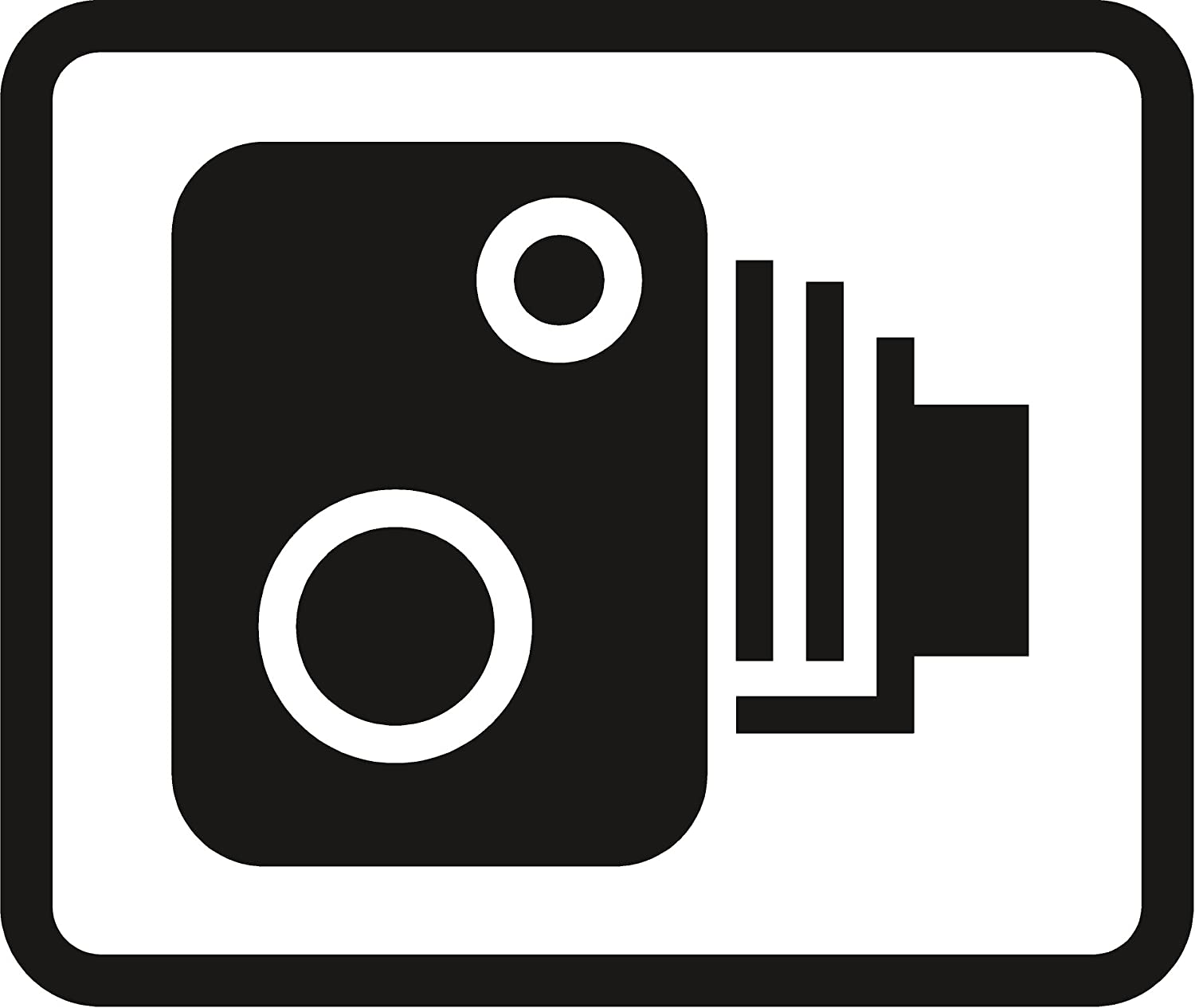
- There's a viewpoint or area of outstanding natural beauty ahead
- You should turn on your speed-camera detection equipment
- Traffic regulations are enforced by cameras in this area
- Only roadside mobile cameras are currently in use

Explanation: This sign reminds all road users that they're entering an area where cameras will monitor traffic regulations. This could include traffic-light cameras and bus-lane cameras, as well as the more common speed cameras.
114. What sort of message is given by a triangular sign?
- Order
- Warning
- Information
- Direction
Explanation: Look at each sign that you pass on the road, so that you don't miss any warnings, orders or information. The shape of the sign will tell you its purpose: triangular signs warn, circles give orders and rectangles inform.
115. What speed limit would you expect to find in residential streets?
- 20 mph
- 25 mph
- 40 mph
- 35 mph
Explanation: In some built-up areas, the speed limit may be reduced to 20 mph. Where there are traffic-calming features, the speed limit may be signed as a 20 mph zone with no repeater signs within the zone. Where there are no traffic-calming features, the 20 mph speed limit is signed at each end of the street and with repeater signs in between. Driving at a slower speed will help give you the time and space to see and deal safely with hazards such as pedestrians and parked cars.
116. What type of emergency vehicle is fitted with a green flashing beacon?
- Road gritter
- Ambulance
- Doctor's car
- Fire engine
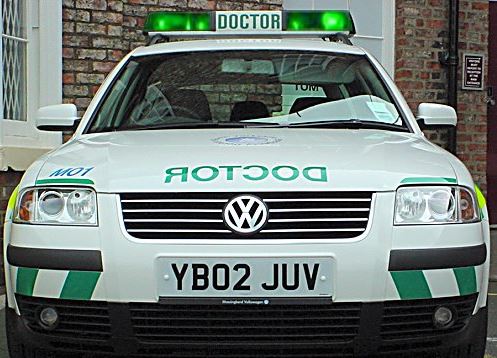
Explanation: A green flashing beacon on a vehicle means the driver or passenger is a doctor on an emergency call. Give way to them if it's safe to do so. Be aware that the vehicle may be travelling quickly.
117. What type of injury can be prevented by a correctly adjusted head restraint?
- Wrist injury
- Facial injury
- Whiplash injury
- Knee injury
Explanation: A properly adjusted head restraint can help to prevent whiplash injury to the neck and spine. You're most likely to suffer this type of injury if you're hit from behind by another vehicle.
118. What type of road uses direction signs with a green background?
- Cycle route
- Primary route
- Urban motorway
- Tourist route
Explanation: A primary route is a road of national or regional importance and is the major route between larger towns and cities. The direction signs on these routes have green backgrounds. Many maps and road atlases show these routes in green.
119. What type of vehicle displays this sign?
- A private ambulance
- An ice-cream van
- A school bus
- A broken-down vehicle
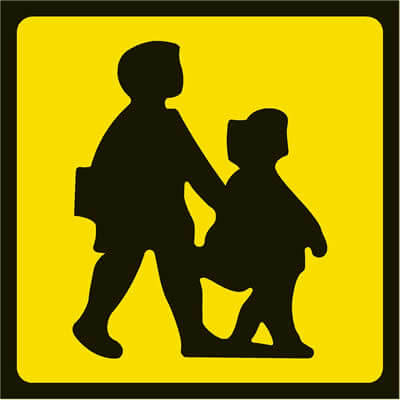
Explanation: Buses that carry children to and from school may stop at places other than scheduled bus stops. Be aware that they might pull over at any time to allow children to get on or off. This will often be when traffic is heavy during the daily commute.
120. What type of vehicle would have a green flashing beacon?
- A doctor's car
- A coastguard patrol car
- A fire engine
- An ambulance
Explanation: If you see a vehicle with a flashing green beacon approaching, it means the driver or passenger is a doctor on an emergency call. Allow it to pass when you can do so safely. Someone's life could depend on the driver making good progress through the traffic.
121. What warning is given by a large white triangle painted on the road surface before a junction?
- Stop at the junction
- Give way at the junction
- The road widens ahead
- Two-way traffic ahead
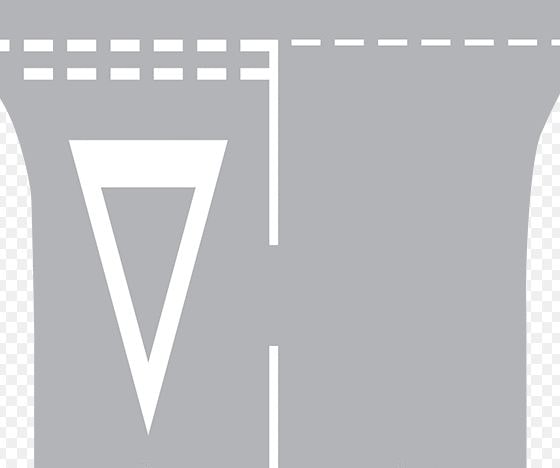
Explanation: Some junctions only have 'give way' lines. This is usually where there's relatively little traffic. 'Give way' signs, and/or road markings, show you that traffic on the road you want to enter has priority.
122. What will a heavy load on your roof rack cause?
- Reduction in stability
- Lighter steering
- Reduction in stopping distance
- Improved road-holding
Explanation: A heavy load on your roof rack will reduce the stability of the vehicle because it moves the centre of gravity away from that intended by the manufacturer. Be aware of this when you drive around bends and corners. If you change direction at speed, your vehicle and/or load could become unstable and you could lose control.
123. What will be affected if you overload your vehicle?
- The gearbox
- The journey time
- The battery life
- The handling
Explanation: Carrying a heavy load in a vehicle will change its centre of gravity. This will affect the vehicle's handling on bends, compared with when it's lightly loaded. It's your responsibility to make sure that your vehicle isn't overloaded and that any load is secure.
124. What will happen if the brake-fluid level falls too low?
- The brakes will overheat
- The brakes will suddenly stop working
- The parking brake will fail
- The brakes will become spongy and inefficient
Explanation: Driving a vehicle with a brake defect could be dangerous and may constitute an offence. Check the brake-fluid level regularly, using the high/low markers on the reservoir. If the fluid level is too low, it could result in loss of braking efficiency.
125. What will happen if the power-assisted steering system fails?
- The steering will become very loose
- The steering will become hard to turn
- The steering mechanism will lock
- The tyres will wear more
Explanation: Most power steering systems only work when the engine is running. If the power steering system fails (or the engine cuts out), much more effort will be needed to steer the vehicle.
126. What will happen if you brake firmly as you drive around a right-hand bend?
- Most of the weight of the car will be transferred onto the rear offside wheel
- Most of the weight of the car will be transferred onto the front offside wheel
- Most of the weight of the car will be transferred onto the rear nearside wheel
- Most of the weight of the car will be transferred onto the front nearside wheel
Explanation: On a right-hand bend, cornering forces will transfer more weight to the nearside wheels. If the brakes are also applied, the transfer of weight forward, combined with the cornering forces, puts more weight on the nearside front tyre - and this makes the car less stable.
127. What will improve your vehicle’s fuel consumption?
- Making short journeys with a cold engine
- Planning well ahead
- Late and harsh braking
- Driving in lower gears
Explanation: As you drive, looking and planning well ahead will help you to avoid harsh braking and keep a smooth, steady pace. This will help to reduce your vehicle's fuel consumption.
128. What will increase your vehicle’s fuel consumption?
- Using tyres that are new or hardly used
- Using tyres of different makes
- Over-inflated tyres
- Under-inflated tyres
Explanation: If your tyre pressures are lower than those recommended by the manufacturer, there will be increased rolling resistance. To overcome this, the engine will have to work harder, resulting in increased fuel consumption. Check your tyre pressures at least once a week.
129. What would a spongy-feeling footbrake indicate?
- Brake fluid on the linings or brake pads
- Badly adjusted brakes
- Air in the braking system
- Worn brake pads
Explanation: A spongy footbrake normally indicates that air has entered the hydraulic system. This may be caused by allowing the fluid level to fall too far, a fluid leak, or moisture ingress. If the brakes feel spongy or slack, have them checked by a qualified mechanic. Test your brakes before the start of every journey. Check the brake fluid regularly but don't overfill it.
130. What’s most likely to cause a crash, if it’s allowed to get too low?
- Radiator coolant level
- Anti-freeze level
- Battery electrolyte level
- Brake-fluid level
Explanation: You should carry out frequent checks on all fluid levels. The brake-fluid level will fall as the friction material on your brake shoes or pads wears down. If it falls below the minimum mark on the fluid reservoir, air could enter the hydraulic system, and this will lead to loss of braking efficiency.
131. What’s most likely to waste fuel?
- Reducing your speed
- Using the wrong grade of fuel
- Having an empty roof rack on your car
- Driving within the speed limit
Explanation: Cars are designed to have an aerodynamic shape; an empty roof rack causes drag and increased wind resistance. The increased wind resistance will waste fuel; it also increases emissions and causes unnecessary pollution to the atmosphere.
132. What’s the main benefit in having four-wheel drive?
- Improved road-holding
- Improved manoeuvrability while parking
- Improved passenger comfort
- Improved fuel economy
Explanation: When all four wheels are driven, there's less chance of the tyres losing their grip, compared with a two-wheel-drive vehicle. But this doesn't replace the skills you need to drive safely. The extra grip helps to prevent skidding when travelling on slippery or uneven roads.
133. What’s the most likely cause of a car pulling to the right when the footbrake is applied?
- The brakes on the left side are inefficient
- Excessive road camber
- The road surface is uneven
- The wheels need balancing
Explanation: If the vehicle pulls to one side when braking, this usually means there's a fault with the brakes on the opposing side. Check your brakes daily - and if you suspect any fault, have them checked as soon as possible. Don't drive with faulty brakes.
134. What’s the most likely cause when the brake pedal feels spongy?
- Air in the hydraulic system
- Worn discs
- Incorrectly adjusted pedal linkages
- Worn brake pads
Explanation: If you operate the brakes when air is in the hydraulic system, they'll have a spongy feel and braking efficiency will be reduced. This is because the air in the system is being compressed as you brake; hydraulic brake fluid alone can't be compressed. If you notice there's a fault with your brakes, have them checked as soon as possible. Don't drive with faulty brakes.
135. What’s the national speed limit for a car on a single carriageway?
- 50 mph
- 70 mph
- 60 mph
- 40 mph
Explanation: On a single carriageway road, the national speed limit will apply, unless signs indicate otherwise. For a car, the limit is 60 mph unless the car is towing a trailer - in which case the limit is reduced to 50 mph.
136. What’s the national speed limit for cars and motorcycles on a dual carriageway?
- 70 mph
- 50 mph
- 30 mph
- 60 mph
Explanation: The speed limit on a dual carriageway or motorway is 70 mph for cars and motorcycles, unless there are signs to indicate otherwise. If your car or motorcycle is towing a trailer, then a lower national speed limit applies. The speed limits for different types of vehicle are listed in The Highway Code.
137. What’s the national speed limit on the motorway for a car?
- 70 mph
- 30 mph
- 60 mph
- 50 mph
Explanation: The speed limit for a car on the motorway is 70 mph. Drive in the left-hand lane whenever possible. Only move to the right to overtake, even if you're travelling at the national speed limit.
140. What’s the purpose of a catalytic converter?
- To reduce the risk of fire
- To reduce fuel consumption
- To reduce engine wear
- To reduce toxic exhaust gases
Explanation: Catalytic converters are designed to reduce toxic exhaust emissions by up to 90%. They have a high normal working temperature and for this reason are inefficient when the engine is cold.
141. What’s the purpose of a continuous white line along the side of the road?
- To show a 'no parking' zone
- To show you're approaching a level crossing
- To show the edge of the carriageway
- To show a 30 mph zone
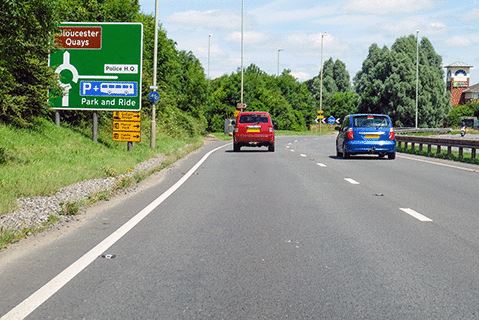
Explanation: The edge of the carriageway is often marked with a continuous white line. This stops at junctions, lay-bys, and entrances and exits from private drives. In conditions of poor visibility, such as when it's foggy, this line can help you see the edge of the road.
142. What’s the purpose of the yellow lines painted across the road?
- To warn you to slow down
- To help you choose the correct lane
- To help you keep the correct separation distance
- To tell you the distance to the roundabout
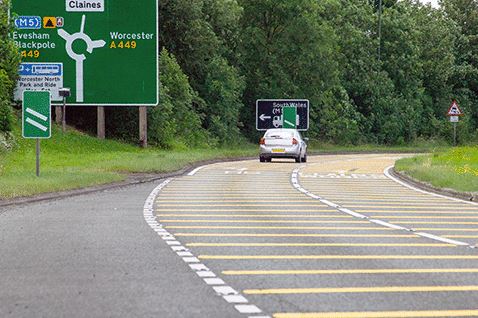
Explanation: These lines are a device often found on the approach to a roundabout or a dangerous junction. They become closer together as you approach the hazard, warning you to slow down.
143. What’s the purpose of these road humps?
- To test vehicle suspension units
- To prevent buses from using these roads
- To slow traffic
- To calibrate satellite navigation systems
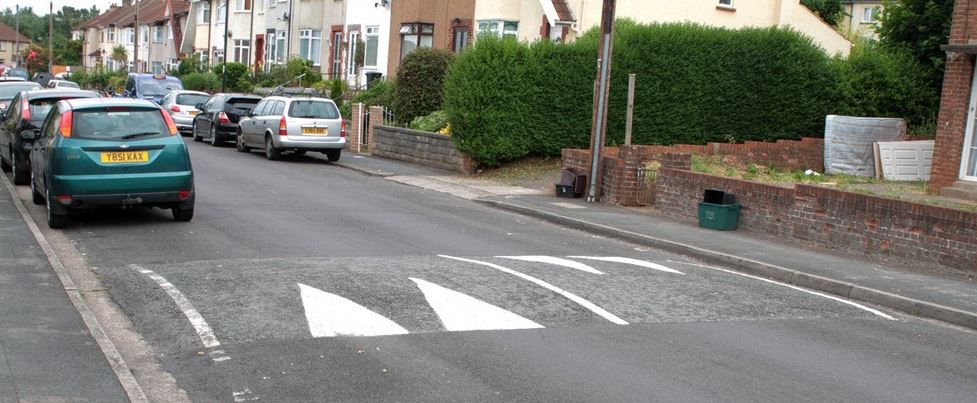
Explanation: Road humps, chicanes and narrowings are all traffic-calming measures designed to keep vehicle speeds low. They're used to protect vulnerable road users near areas such as housing estates and shopping centres.
144. What’s the purpose of yellow crisscross lines at a junction?
- To make you more aware of the traffic lights
- To guide you into position as you turn
- To prevent the junction from becoming blocked
- To show you where to stop when the lights change
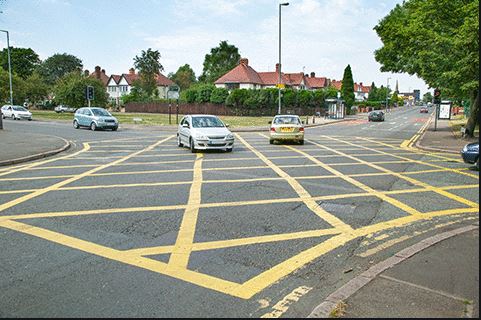
Explanation: Box junctions are designed to keep junctions clear by preventing vehicles from stopping in the path of crossing traffic. A pupil should be taught not to enter the yellow-box area if their exit road isn't clear. The only exception is when a driver wants to turn right but is prevented from doing so by oncoming traffic.
145. When are you advised to increase your tyre pressures so that they’re higher than normal?
- When you'll be filling the fuel tank
- When you'll be driving at high speeds over long distances
- When you'll be driving on very rough roads
- When you'll be driving in cold or wet weather
Explanation: In general, the vehicle handbook will recommend higher tyre pressures for continuous high-speed driving; for example, on long motorway trips. Increased tyre pressures may also be recommended when the vehicle is carrying a heavy load or when towing a trailer.
146. When are you allowed to stop on a motorway?
- When there's a red cross with flashing red lights above every lane
- If you need to walk and get fresh air
- When you need to use your mobile telephone
- If you wish to pick up hitchhikers
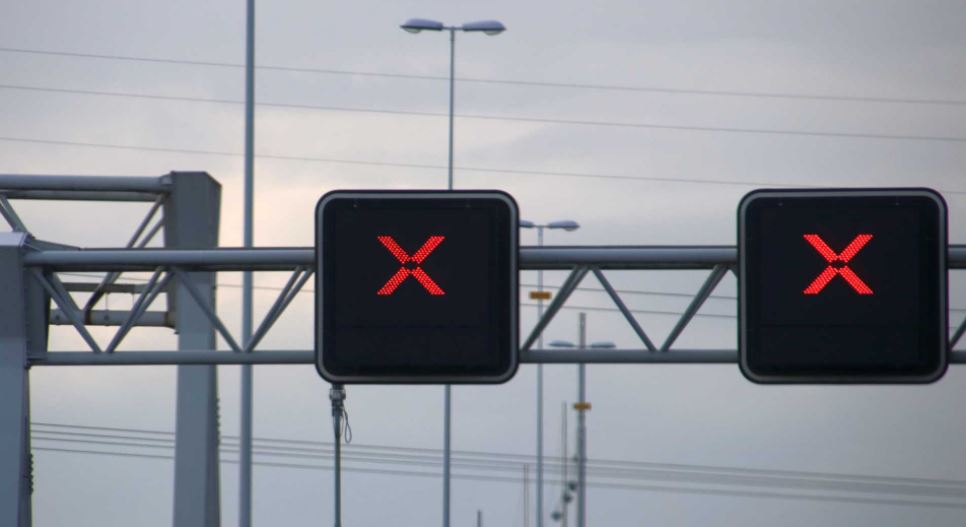
Explanation: You must stop if there's a red cross with red lights flashing above every lane on the motorway. However, if the signs over any of the other lanes don't show this signal, you may move into one of those lanes and continue, if it's safe to do so.
147. When are you allowed to use your vehicle’s hazard warning lights?
- When you're driving at night without headlights
- When you've parked on double yellow lines
- When you've stopped your vehicle and it's temporarily obstructing traffic
- When you're driving slowly because you're lost
Explanation: Use hazard warning lights when your vehicle is stationary, to warn that it's temporarily obstructing traffic. Never use them to excuse dangerous or illegal parking. You may also use hazard warning lights while you're driving on a motorway or unrestricted dual carriageway if you need to warn traffic behind of a hazard ahead.
148. When can car drivers use a bus lane identified by this sign?
- When other cars are using it
- When it's clear of buses
- At no time
- During the hours of daylight
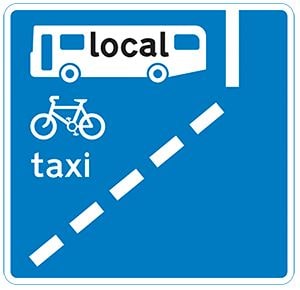
Explanation: Some bus lanes only operate during peak hours and other vehicles may use them outside these hours. Make sure you check the sign for the hours of operation before driving in a bus lane. Where no hours are shown, the bus lane operates 24 hours a day.
149. When can you enter this hatched area?
- Never under any circumstances
- When necessary and you can see it's safe to do so
- Only to overtake large vehicles
- Only in an emergency
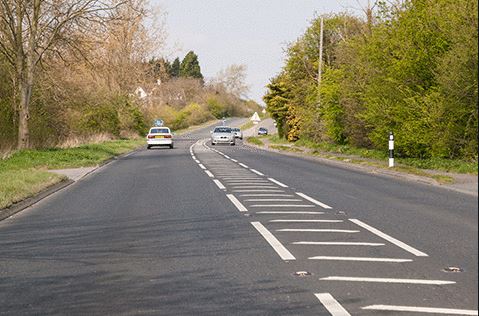
Explanation: This hatched area is bordered by broken lines; in normal driving, there shouldn't be a need to enter or cross the hatched area. When exceptional circumstances arise (for example, the need to pass a temporary obstruction or a slow-moving vehicle), you may drive on a hatched area when you're sure that it's safe to do so. Where hatched areas are bordered by a solid line, you mustn't enter the area except in an emergency.
150. When could you stop here on this road?
- To park during the hours of darkness
- To park during daylight hours
- To set down or pick up passengers
- To rest if you're tired
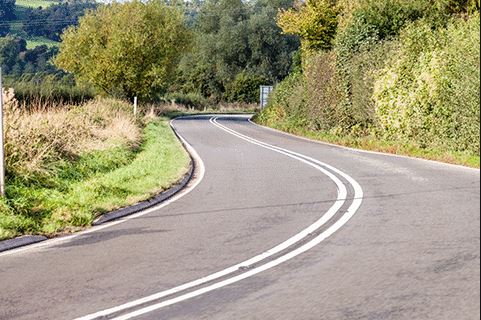
Explanation: Normally, a driver shouldn't stop or park on a road that has double white lines along the centre. However, you may stop for long enough to set down or pick up passengers, or to load or unload goods.
151. When may you cross double solid white lines along the centre of the road?
- To pass a tractor travelling at 20 mph
- To pass a road sweeper travelling at 15 mph
- To pass a traffic queue at a junction
- To pass parked vehicles on your side of the road
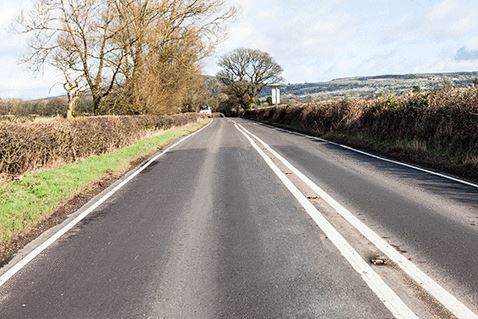
Explanation: When it's safe to do so, you may cross the solid white line to pass a stationary vehicle or to pass a pedal cycle, horse or road maintenance vehicle if they're travelling at 10 mph or less. You may also cross the solid line to enter a side road or access a property.
152. When may you drive or park in a cycle lane marked by a solid white line?
- Outside its period of operation
- During the hours of daylight
- Outside peak times
- During the hours of darkness
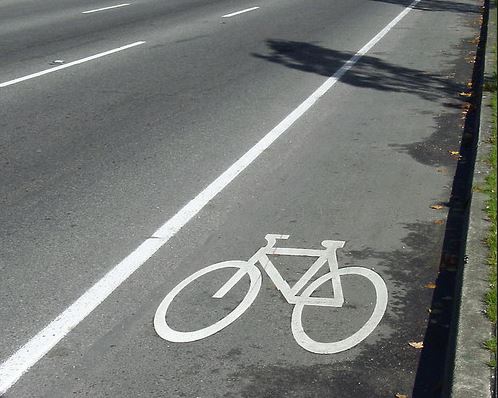
Explanation: It's illegal to drive or park in a cycle lane marked by a solid white line during its hours of operation. Parking in a cycle lane will obstruct cyclists; they may move into the path of traffic on the main carriageway as they ride around the obstruction. This could be hazardous both for the cyclist and for other road users.
153. When may you use hazard warning lights while you’re driving?
- When you slow down suddenly on a motorway
- When you need to warn oncoming traffic that you intend to stop
- When you slow down at a pedestrian crossing
- When your direction indicators aren't working properly

Explanation: You may use hazard warning lights when you slow suddenly on a motorway or unrestricted dual carriageway, to warn traffic behind of a hazard ahead. Never use hazard warning lights to excuse dangerous or illegal parking.
154. When may you wait in a box junction?
- When you're in a queue of traffic turning left
- When oncoming traffic prevents you from turning right
- When traffic lights are green
- When you're in a queue of traffic to go ahead
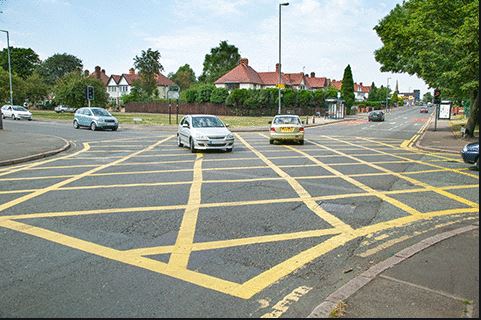
Explanation: The purpose of this road marking is to keep the junction clear of queuing traffic. You may only wait in the marked area when you're turning right and your exit lane is clear but you can't complete the turn because of oncoming traffic.
155. When must you stop on a motorway?
- When a red cross with flashing red lights shows above every lane
- When your mobile phone rings
- When you're tired and need a rest
- When you have to read a map
Explanation: You may only stop on the carriageway of a motorway
- when told to do so by the police
- when a red cross with flashing red lights shows above every lane - in a traffic jam
- in an emergency or breakdown.
156. When should regular tyre-pressure checks be made?
- After travelling at high speed
- When tyres are hot
- After any lengthy journey
- When tyres are cold
Explanation: Check the tyre pressures when the tyres are cold. Warm or hot tyres may give a misleading reading.
157. When will anti-lock brakes be activated?
- When you're speeding on a slippery road surface
- When you don't brake quickly enough
- When excessive brake pressure has been applied
- When you haven't seen a hazard ahead
Explanation: If your car is fitted with an anti-lock braking system (ABS), this will activate when you brake so hard that the tyres start to lose their grip on the road surface. At this point, the wheels would normally lock up and a skid would start. The ABS senses the wheel locking and releases the brake pressure just enough to avoid the skid. It then cycles through applying and releasing the brake pressure many times per second. This ensures maximum braking for the available grip is constantly applied without the wheels locking.
158. When would you inflate your tyres above the recommended normal pressure?
- When the roads are slippery
- When the tyre tread is worn below 2 mm
- When you'll be driving fast for a long distance
- When you'll be driving in cold weather
Explanation: Check the vehicle handbook: this should give you guidance on the correct tyre pressures for your vehicle. There may be recommendations to increase the tyre pressure when carrying heavy loads or when travelling continuously at higher speeds, such as when using a motorway.
159. Where are amber reflective road studs used?
- Along the central reservation on a motorway or dual carriageway
- Across the entrance to a service area
- Across the road at a pedestrian crossing
- Along the edge of an escape lane on a steep downhill gradient
Explanation: Coloured studs are used to help you judge your position on the carriageway in poor visibility. Knowing which colour is used and where can help keep you safe. Amber studs are used between the right-hand lane and the central reservation on a motorway or dual carriageway.
160. Where are fluorescent green/yellow reflective studs used to mark the carriageway?
- Between the edge of the carriageway and the central reservation
- At contraflow systems and roadworks
- Across the road, marking where roadworks start and finish
- At slip-road exits and entrances
Explanation: Fluorescent green/yellow reflective studs indicate temporary lane changes, such as at roadworks and contraflow systems. The lanes are often narrower than normal lanes. You should obey any speed restrictions through the roadworks.
161. Where are the amber reflective studs on a motorway?
- Between the acceleration lane and the carriageway
- Between the hard shoulder and the carriageway
- Between the central reservation and the carriageway
- Between each pair of lanes
Explanation: On motorways, reflective studs are set into the road to help you navigate in the dark and in conditions of poor visibility. Amber-coloured studs are on the right-hand edge of the main carriageway, next to the central reservation.
162. Where do waiting restrictions allow you to stop to pick up or set down passengers?
- At school entrances
- At bus stops
- On urban clearways
- On Red Routes
Explanation: Waiting restrictions help to keep the road clear by preventing parking that will hinder the flow of traffic. Waiting restrictions on urban clearways allow vehicles to stop and pick up or set down passengers, even during their hours of operation.
163. Where should the head restraint be positioned for it to be most effective?
- At least as high as the shoulders
- At least as high as the eyes or top of the ears
- In the highest position and tilted backwards
- In the lowest position and pointing forwards
Explanation: An incorrectly adjusted head restraint will offer reduced protection against whiplash injury. When adjusting the head restraint, set it so that it's at least as high as the eyes or top of the ears.
164. Where would you find a catalytic converter on your vehicle?
- In the air filter
- On the exhaust system
- On the cooling system
- In the fuel tank
Explanation: Strict controls on exhaust emissions require a catalytic converter to be fitted to the exhaust system of all new vehicles. Catalytic converters remove most of the carbon monoxide, oxides of nitrogen and unburned hydrocarbons from the exhaust gases.
165. Where would you see a contraflow bus and cycle lane?
- On a one-way street
- On an urban motorway
- On a dual carriageway
- On a roundabout

Explanation: The traffic that's permitted to use a contraflow lane travels in the opposite direction to traffic in the other lanes on the road. This is to help public transport make full use of the road network in places that would otherwise be unavailable, such as one-way streets.
166. Which colour light shows before the flashing amber signal at a pelican crossing?
- Steady amber
- Red
- Red and amber together
- Green
Explanation: The flashing amber light allows time for pedestrians to finish crossing. If the crossing is clear and it's safe, you may drive on before the green light shows.
167. Which light won’t show to a driver at a puffin crossing?
- Flashing amber
- Green
- Steady amber
- Red
Explanation: A flashing amber light is shown at pelican crossings, but not at puffin crossings. Puffin crossings are controlled electronically and detect when pedestrians are on the crossing. The red light will remain showing to drivers until the system detects that the crossing is clear. The sequence of lights is then the same as for normal traffic lights.
168. Which road surface may cause anti-lock brakes to be less effective?
- A dry surface
- A loose surface
- A firm surface
- A good surface
Explanation: If the road surface is loose, it's possible for the loose surfaces to slide over each other. A vehicle's tyres may grip the surface layer but this may slide across a lower layer. An anti-lock braking system would be less effective in this situation.
169. Which road users are most likely to be permitted to share a bus lane during its times of operation?
- Cyclists
- Drivers towing caravans
- Delivery drivers
- Drivers of small vans
Explanation: Most bus lanes may also be used by cyclists. The bus-lane sign will show its times of operation (where time limits apply) and any other vehicles that may also use the bus lane.
170. Which road users can use a toucan crossing?
- Horse riders and cyclists
- Cyclists and pedestrians
- Horse riders and pedestrians
- Moped riders and cyclists
Explanation: Most pedestrian crossings are for pedestrians only, but the toucan crossing has been designed to be shared by both pedestrians and cyclists. You can expect to find a toucan crossing where a cycle route and a footpath cross a road at the same point.
171. Which sign shows a lane for use by pedal cycles only?

172. Which stream of traffic has priority at a roundabout?
- Vehicles approaching a roundabout always have priority
- Traffic on the roundabout always has priority
- Priority should be given to cars towing a trailer or caravan
- Signs, road markings or traffic lights show the priority
Explanation: Before you enter a roundabout, you normally give way to any traffic approaching from your immediate right. In a few cases, however, traffic on the roundabout has to give way to traffic entering. Look out for 'give way' signs, road markings and traffic lights on the roundabout.
173. Which traffic-light signal will follow a red light?
- Amber
- Red and amber
- Amber and green
- Green
Explanation: Knowing the sequence of traffic lights allows you to plan your approach. This can help prevent excessive braking or hesitation at the junction.
174. Which type of vehicle is allowed to pass this sign?
- Small lorry
- Private taxi
- Pedal cycle
- Minibus
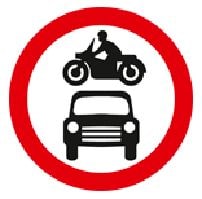
Explanation: This sign prohibits all motor vehicles. Only pedal cycles may pass it. However, a black-and-white plate underneath the sign may give exemptions; for example, 'except buses' or 'except for access'.
175. Which vehicle is least likely to be affected by side winds?
- Motorcycle
- Bicycle
- Car
- High-sided vehicle
Explanation: Although cars are the least likely to be affected, side winds can affect anyone, especially
- after overtaking a large vehicle
- when passing gaps between hedges or buildings
- on exposed sections of road.
176. While you’re driving, what will happen if you hold the clutch pedal down or roll in neutral for too long?
- You'll wear out the tyres more quickly
- You'll cause the engine to overheat
- You'll reduce your control over the vehicle
- You'll increase the amount of fuel the vehicle uses
Explanation: Holding the clutch down or staying in neutral for too long will cause your vehicle to freewheel. This is known as 'coasting' and it's dangerous, because it reduces your control of the vehicle.
177. Who has priority when traffic lights are out of order?
- Traffic turning right
- Traffic turning left
- Nobody
- Traffic going straight on
Explanation: When traffic lights are out of order, you should treat the junction as an unmarked crossroads. Be cautious, as you may need to give way or stop. Keep a lookout for traffic attempting to cross the junction at speed.
178. Who should obey diamond-shaped signs?
- Tram drivers
- Car drivers
- Cyclists
- Pedestrians
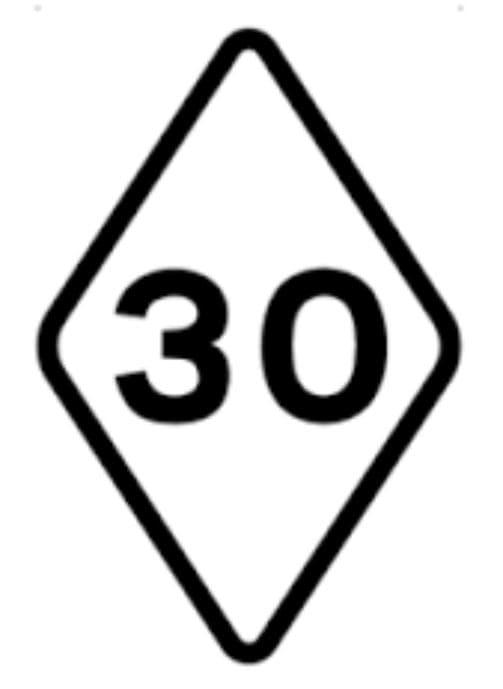
Explanation: These signs are directed at tram drivers. By knowing what they mean, you'll be able to anticipate the actions of the driver.
179. Why are new vehicles fitted with catalytic converters?
- To control exhaust noise levels
- To allow the exhaust system to be recycled
- To prolong the life of the exhaust system
- To reduce harmful exhaust emissions
Explanation: Engines burning fossil fuels produce harmful gases. We need to be concerned about the effect this has on our environment. A catalytic converter acts like a filter, removing most of the harmful compounds from the exhaust gas.
180. Why are these yellow lines painted across the carriageway?
- To make drivers aware of their speed
- To indicate a 'no parking' area
- To help drivers keep the correct separation distance
- To tell drivers not to change lanes
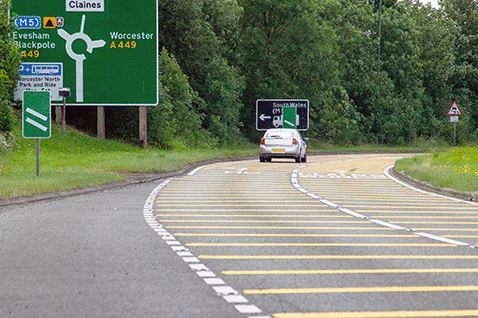
Explanation: Yellow lines can be found on the approach to some roundabouts and dangerous junctions. The lines may be raised, which will change the sound of your car's contact with the road. In this way, you'll have both visible and audible warnings to adjust your speed.
181. Why are vehicle mirrors often slightly convex?
- To give a wider field of vision
- To totally cover blind spots
- To make traffic behind look bigger
- To make it easier to judge the speed of traffic behind
Explanation: A convex mirror gives a wide view of the scene behind. However, it won't show you everything behind, or to the side of, your vehicle. Before you move off, look over your shoulder to check for anything that's not visible in the mirrors.
182. Why are vehicles fitted with high-intensity rear fog lights?
- To make them more visible in thick fog
- To help them to be seen when they're being driven at high speed
- To warn drivers following too closely to drop back
- In case they break down in a dangerous position
Explanation: A high-intensity rear fog light helps drivers behind to see that there's a vehicle ahead, even though its outline can't be seen due to fog.
183. Why are yellow lines painted across the road on the approach to some roundabouts?
- To warn you to choose the correct lane
- They warn of a change in speed limit
- To make you aware of your speed
- They show a 'no overtaking' area
Explanation: Yellow lines are painted across the road on the approach to some roundabouts. The lines are usually found on dual carriageways, where traffic speeds are higher, or at the end of motorway exit slip roads. They provide a visual warning to remind drivers to check their speed.
184. Why could keeping the clutch down or selecting neutral for long periods of time be dangerous?
- Fuel spillage will occur
- You'll have less steering and braking control
- Engine damage may be caused
- The tyres will wear out more quickly
Explanation: Letting your vehicle roll or coast in neutral reduces your control over steering and braking. This can be dangerous on downhill slopes, where your vehicle could pick up speed very quickly.
185. Why could keeping the clutch down or selecting neutral for long periods of time be dangerous?
- Fuel spillage will occur
- You'll have less steering and braking control
- Engine damage may be caused
- The tyres will wear out more quickly
Explanation: Letting your vehicle roll or coast in neutral reduces your control over steering and braking. This can be dangerous on downhill slopes, where your vehicle could pick up speed very quickly.
186. Why have ‘Red Routes’ been introduced into major cities?
- To help the traffic flow
- To raise the speed limits
- To provide better parking
- To allow lorries to load more freely
Explanation: Traffic signs and continuous red lines painted along the edge of the road identify a Red Route. Parking is banned along these routes and enforcement officers have powers to remove any vehicle that's illegally parked. These powers are in place to ensure the route remains unobstructed and so help the free flow of traffic.
187. Why is a toucan crossing different from other crossings?
- Moped riders can ride across it with pedestrians
- It's controlled by a traffic warden
- Cyclists can ride across it with pedestrians
- It's controlled by two flashing lights
Explanation: Toucan crossings are shared by pedestrians and cyclists. Cyclists are permitted to cycle across with pedestrians when they're shown the green light together. The signals are push-button operated and there's no flashing amber phase.
188. Why is coasting a bad driving technique?
- It causes the engine to stall
- It stops engine braking from slowing the car
- It increases fuel consumption
- It makes the engine run faster
Explanation: When coasting, the engine is disconnected from the drive to the wheels. This means that the engine's resistance can't be used to help slow the vehicle, especially when travelling downhill. There will be a little coasting every time you change gear; this can't be avoided, but it should be kept to a minimum.
189. Why is it particularly important to carry out a check on your vehicle before making a long motorway journey?
- The road surface will wear down the tyres faster
- You'll have to do more harsh braking on motorways
- Motorway service areas don't deal with breakdowns
- Continuous high speeds increase the risk of your vehicle breaking down
Explanation: Before you start a motorway journey, make sure that your vehicle can cope with the demands of continuous high-speed travel. To reduce the risk of your vehicle breaking down, check the oil, water and tyres before setting off. If you're travelling a long way, it's also a good idea to plan your rest stops in advance.
190. Why should you make sure that your indicators are cancelled after turning?
- To avoid damage to the indicator relay
- To avoid flattening the battery
- To avoid dazzling other road users
- To avoid misleading other road users
Explanation: If your indicators don't turn off automatically, you must cancel them. This might happen after a slight deviation, where the movement of the steering wheel hasn't been enough to activate the auto-cancel mechanism. A signal that continues to show after it should have cancelled can mislead other road users.
191. Why should you make sure your head restraint is properly adjusted?
- It protects you from whiplash injury
- It makes you more comfortable
- It makes you relax
- It helps you to maintain your concentration
Explanation: In a crash, the occupants of a vehicle can be thrown violently forward and then back again. The head restraint should be adjusted so that it gives maximum protection to the neck as the occupant is thrown backwards.
192. Why should you never wave people across at pedestrian crossings?
- Because they may not be looking
- Because they may not be ready to cross
- Because it's safer for you to carry on
- Because there may be another vehicle coming
Explanation: If people are waiting to use a pedestrian crossing, slow down and be prepared to stop. Don't wave them across the road, as another driver may not have seen them or your signal and may not be able to stop.
193. Why should you take care to avoid spillage when refueling a vehicle fitted with a diesel engine?
- Diesel is sticky
- Diesel is odourless
- Diesel is unstable
- Diesel is slippery
Explanation: The diesel you use to run a vehicle is a form of oil and, as such, is very slippery when spilt on the road. The usual places to find diesel spillage are near filling stations and on bends or roundabouts. Overfilled fuel tanks and poorly fitting or missing fuel filler caps are often the cause of diesel spillage, so make sure you replace your fuel filler cap securely after refueling.
194. Why should you tell your pupil to obey the speed limit shown on this sign?
- To reduce the amount of chippings thrown up by the tyres
- To prevent damage to the new road surface
- To prevent other drivers from driving too fast over the chippings
- To comply with the law
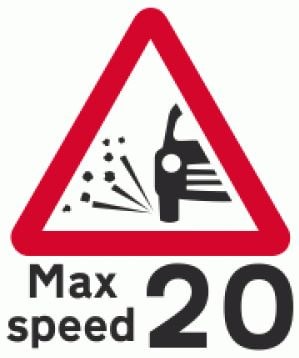
Explanation: Stone chippings are often used to finish off a new road surface. They may take several days to bed into the tar underneath. Advisory speed limits are used to help reduce the amount of chippings thrown up by passing vehicles. Chippings can cause damage to vehicles and other road users - especially cyclists, pedestrians and horse riders. There's also an increased risk of skidding on the loose surface.
195. Why should you test your brakes after driving through a ford?
- To bleed air from the brake system
- To make sure you can stop safely
- To remove the water from your tyres
- To check your brake lights are working
Explanation: At a ford, the road passes through a stream at a place where the water is normally shallow. When you've gone through the water, you should test your brakes and if necessary dry them out. To do this, first check that you won't cause danger to traffic behind. Then apply a light brake pressure while moving slowly. Make sure your brakes are working properly before resuming normal driving.
196. Why would you fit chains to your wheels?
- To prevent the brakes from locking
- To prevent skidding in deep snow
- To prevent wear to the tyres
- To prevent damage to the road surface
Explanation: Snow chains can be fitted to your tyres when snow affects the driving conditions. They can help you to move off from rest or to keep moving in deep snow. You'll also need to adjust your driving to deal with these conditions; don't rely on technology such as anti-lock brakes to overcome bad driving choices.
197. Why would you flash your headlights to another road user?
- To let them know that you're there
- To show that you're about to turn
- To tell them that you have right of way
- To show that you're giving way to them
Explanation: You should only flash your headlights to warn others of your presence. Don't use them to
- greet others
- show impatience
- give up your priority.
Other road users could misunderstand your signal.
198. You apply the brakes while you’re travelling forwards and in a straight line. How will this affect the grip of the tyres on the road?
- The tyres won't grip until you brake firmly
- The rear tyres will grip the road more than the front tyres
- The grip will remain constant on all four tyres
- The front tyres will grip the road more than the rear tyres
Explanation: If you brake while travelling in a straight line, the inertia of the vehicle tries to keep it moving forward. This moves the weight of the vehicle forward and onto the front wheels. This extra load on the front tyres will press them more firmly into contact with the road, giving more tyre grip.
199. You have to make a journey in fog. What’s the most important thing you should do before you set out?
- Check the battery is fully charged
- Make sure you have a warning triangle
- Top up the radiator with anti-freeze
- Make sure your lights are working
Explanation: Before starting any journey, make sure your windows and mirrors are clean and your lights are working. You need to be able to see clearly and be seen by other road users. This is especially important when visibility is reduced, as in fog or heavy rain.
200. You intend to slow down to give way to pedestrians at a zebra crossing. Why could an arm signal be useful?
- To make all traffic behind stop
- It gives the pedestrians immediate priority
- You must tell other drivers to stop
- Other road users can see the arm signal and act accordingly
Explanation: When approaching a zebra crossing where you intend to stop, using an arm signal can be helpful. This not only tells the vehicles behind that you intend to stop, but also informs approaching traffic and waiting pedestrians, who can't see your brake lights.
201. You park on a hill in a vehicle that has automatic transmission. When you leave the vehicle, in which position would you put the gear selector?
- Neutral
- Drive
- Park
- Reverse
Explanation: When parking a vehicle with automatic transmission, the gear selector should be moved to the 'P' (Park) position. This locks the transmission and prevents the vehicle from moving forwards or backwards. This will stop it from rolling away should the parking brake fail.
202. You park on the left, facing uphill. In which position should you leave the steering wheel?
- Straight ahead
- Turned to the right
- In the locked position
- Turned to the left
Explanation: When you park a vehicle facing uphill and on the left, turn the steering wheel to the right. If the parking brake fails, this will give the front wheels the least distance to travel before wedging against the kerb, preventing the vehicle from rolling further. It's also a good idea to leave the car in gear, or select 'P' on an automatic.
203. You see a pedestrian with a dog. What does it mean if the dog is wearing a distinctive yellow or burgundy coat?
- The person has hearing difficulties
- The person is colour-blind
- The person is elderly
- The person is dog-training
Explanation: If you see a pedestrian with a dog that's wearing a yellow or burgundy coat, take care. The pedestrian may have hearing difficulties and so be unable to hear you approaching.
204. You see a vehicle with a flashing amber beacon ahead. What warning does this give you?
- The vehicle is a doctor's car
- The vehicle is carrying flammable goods
- The vehicle is slow-moving
- The vehicle is a fire engine
Explanation: Slow-moving vehicles, such as a salt spreader or breakdown vehicle, may use a flashing amber beacon. On unrestricted dual carriageways, vehicles with a maximum speed of 25 mph (40 km/h) or less must use a flashing amber beacon.
205. You see white diagonal lines, bounded by broken lines, painted on the road. One of their uses is to protect traffic turning right. What other purpose do these markings have?
- To provide a space for emergency vehicles
- To provide space for overtaking motorcyclists
- To allow extra space for wide loads
- To separate streams of traffic
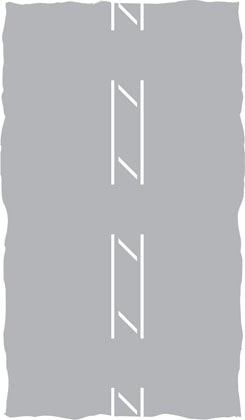
Explanation: Hatch markings bounded by broken white lines are designed to separate traffic lanes or to protect traffic turning right. Only drive into these areas if it's necessary and you can see that it's safe.
206. You want to turn right at a box junction. What should you do if there’s oncoming traffic?
- Drive on, because you can't turn right at a box junction
- Drive into the box junction when signalled by oncoming traffic
- Wait before the junction until it's clear of all traffic
- Wait in the box junction if your exit road is clear
Explanation: You can move into a box junction as long as your exit road is clear. You can stop and wait in the junction when you want to turn right and have to wait for a gap in the oncoming traffic.
207. Your car is fitted with anti-lock brakes. What technique should you use to stop in an emergency?
- Press the brake pedal firmly until you've stopped
- Apply the parking brake to reduce the stopping distance
- Brake normally and avoid turning the steering wheel
- Keep pushing and releasing the footbrake quickly to prevent skidding
Explanation: To use anti-lock brakes in an emergency, you should brake firmly until you've come to a stop. The anti-lock mechanism will activate automatically if it senses the wheels are about to lock.
208. Your car’s front wheels are out of balance. How will this affect your car?
- They'll cause the steering to vibrate
- They'll cause the tyres to deflate
- They'll cause the brakes to fail
- They'll cause the steering to pull to one side
Explanation: If your front wheels are out of balance, the steering will vibrate. You'll have to take your vehicle to a garage or tyre-fitting firm, where they can balance your wheels; it isn't a fault that will rectify itself.
209. Your pupil asks what the blue patch means on this sign. What’s the best reply?
- It shows an alternative route for non-motorway traffic
- The road ahead leads to a junction with a motorway
- The road ahead is being upgraded to a motorway
- Motorway regulations apply on the road immediately ahead
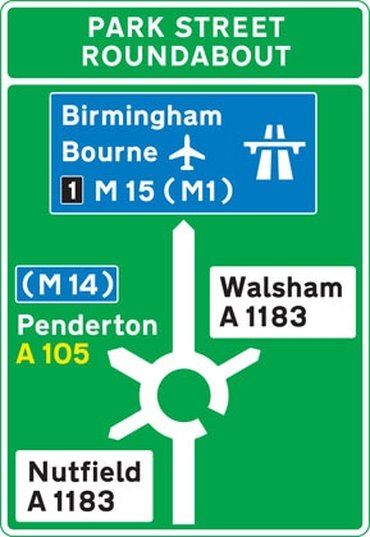
Explanation: A motorway number in brackets on a blue patch means that a motorway junction will be reached by following the route indicated.
210. Your pupil asks you about this sign, which they’ve seen recently. What should you tell them it means?
- Restricted route on a main road
- Ring road on a primary route
- Red Route on a primary route
- Road restricted on a tram route
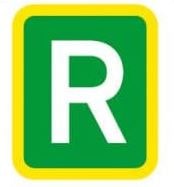
Explanation: Ring roads are designed to keep traffic away from town centres. Unless you need to visit the town centre, you should use the ring road, as this will help to avoid congestion and reduce your journey time.
211. Your pupil is driving in a stream of traffic. You see this sign ahead. What advice should you give to your pupil?
- Look out for water on the roads
- Slow down at once by braking sharply
- Slow down and try your brakes
- Keep well back from the vehicle in front

Explanation: Loose gravel or chippings can easily be thrown up by vehicles' tyres. At road works or on newly surfaced roads, check your speed and keep a good distance away from vehicles ahead to avoid any flying chippings.
212. Your vehicle has anti-lock brakes. In which conditions may they be ineffective at preventing skidding?
- In foggy conditions
- On dry tarmac
- At night on unlit roads
- On surface water
Explanation: In very wet weather, water can build up between the tyre and the road surface. As a result, your vehicle rides on a thin film of water and your tyres won't grip the road. Gravel or shingle surfaces also offer less grip and can cause problems when braking. An anti-lock braking system may be ineffective in these conditions.
213. Your vehicle is fitted with anti-lock brakes. How should you use your brakes to stop quickly in an emergency?
- Brake gently and pump the brake pedal on and off
- Brake firmly and pump the brake pedal on and off
- Brake rapidly once, and immediately release the brake pedal
- Brake rapidly and firmly, without releasing the brake pedal
Explanation: On vehicles fitted with an anti-lock braking system, it's generally recommended that, once you've applied the brake, you keep your foot firmly on the pedal until you've stopped. Releasing the brake and reapplying it will momentarily disengage the anti-lock braking system and may increase your stopping distance.
214. You’re about to drive down a steep hill. What should you do to control the speed of your vehicle?
- Select a low gear and use the footbrake
- Select a high gear and pump the footbrake
- Select a high gear and use the footbrake with the parking brake
- Select a low gear and use the footbrake with the parking brake
Explanation: When travelling down a steep hill, your vehicle will tend to increase speed. This will make it more difficult for you to stop. To maintain control and prevent the vehicle from running away
- select a lower gear - the engine will then help to control your speed
- use the footbrake to maintain control.
215. You’re about to reverse into a side road. What should you do if you see a pedestrian who wants to cross behind your car?
- Reverse before the pedestrian starts to cross
- Give way to the pedestrian
- Wave to the pedestrian to cross
- Wave to the pedestrian to stop
Explanation: Look all around before and during any manoeuvre. Always stop and give way to any pedestrians who wish to cross the road behind your vehicle. The shape and size of your vehicle can restrict visibility; be aware that there may be a small child or a low obstruction hidden from view.
216. You’re approaching a junction where the traffic lights aren’t working. What should you do when a police officer gives this signal?
- Stop level with the officer's arm
- Turn left only
- Turn right only
- Stop at the stop line
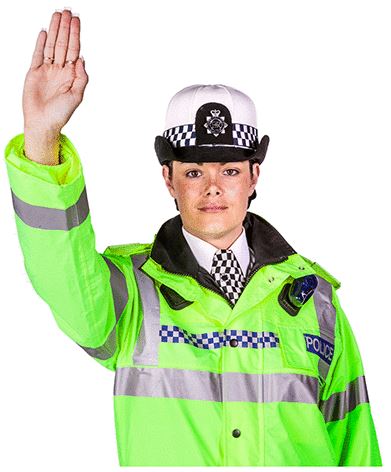
Explanation: If a police officer or traffic warden directing traffic signals you to stop, you must obey them. They'll use the arm signals shown in The Highway Code. If they're controlling traffic where traffic lights have failed, react to their signal as though it had been given by the traffic lights.
217. You’re approaching a pelican crossing. What should you do if the amber light is flashing?
- Only continue when the green light appears
- Stop even if the crossing is clear
- Encourage waiting pedestrians to cross
- Give way to pedestrians who are crossing
Explanation: At a pelican crossing, there's a phase where the amber light flashes. This will show after the red light and gives pedestrians time to finish crossing safely. For drivers, the flashing amber light means they may drive on if the crossing is completely clear, but they must wait if pedestrians are still on the crossing.
218. You’re approaching a red light at a puffin crossing. Pedestrians are on the crossing. When will the red light change?
- When the pedestrians have reached a safe position
- When sensors detect your vehicle approaching
- When the pedestrians are clear of the front of your vehicle
- When a driver from the opposite direction reaches the crossing
Explanation: At a puffin crossing, an electronic device will keep the red light showing until it detects that the pedestrians have reached a safe position. Don't proceed until the green light shows - and then, only if it's safe to do so.
219. You’re approaching this sign. Which sign are you likely to have just passed?
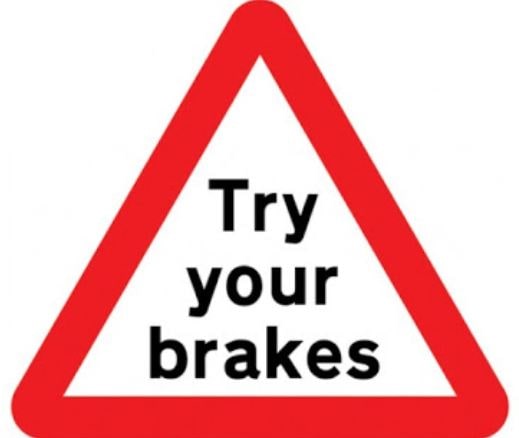

Explanation: If you've driven through a ford, your brakes may be wet. This can make them less effective. Make sure it's safe, then try them by pushing gently on the brake pedal. If they're not fully effective, gently apply light pressure while driving slowly. This will help to dry them out.
Risk of brake failure after crossing a ford or before descending a steep gradient
220. You’re approaching traffic lights. What does the amber light on its own mean?
- Stop at the stop line
- Go if no pedestrians are crossing
- Prepare to go
- Go if the way is clear
Explanation: As you approach traffic lights that have been on green for some time, anticipate that they'll soon change. Check your mirror so that you know what traffic is behind you and how far away it is. If the lights change to steady amber, you should stop behind the stop line. If you're so close to the stop line when the lights change that to stop may cause a collision, you should continue. You'll only know the risk from traffic behind if you use your mirrors as you approach the lights.
221. You’re approaching traffic lights. What should you do if the red and amber lights are showing together?
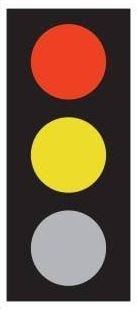
- Drive past the lights if the road is clear
- Take care: there's a fault with the lights
- Stop, because the lights are about to change to red
- Wait for the green light and only drive on if the road is clear
Explanation: Be aware that other traffic might still be clearing the junction. When the green light shows, make sure the way is clear before continuing.
222. You’re at a junction controlled by traffic lights. When should you wait, even if the green light is showing?
- When pedestrians are waiting to cross
- When you intend to turn right
- When your exit from the junction is blocked
- When you think the lights may be about to change
Explanation: As you approach traffic lights, look into the road you wish to take. If the road is blocked, hold back, even if the green light shows.
223. You’re at a pelican crossing. What does the flashing amber light mean?
- Give way to pedestrians on the crossing
- Stop and wait for the green light
- Stop and wait for the red light
- Give way to pedestrians waiting to cross
Explanation: Pelican crossings are signal-controlled crossings operated by pedestrians. Push-button controls change the signals. Pelican crossings have no red-and-amber stage before green. Instead, they have a flashing amber light, which means you must give way to pedestrians on the crossing, but if it's clear, you may continue.
224. You’re driving a car fitted with automatic transmission. What should you do when you approach a very steep downhill gradient?
- Slow down, so that the automatic transmission changes down to a lower gear
- Slow down and use the gear selector to hold the car in a low gear
- Remain in 'D' (Drive) and keep the speed in check with the footbrake
- Use 'kick-down' to change the vehicle into a lower gear
Explanation: A vehicle fitted with an automatic transmission usually changes to a higher gear as its speed increases and to a lower gear as it falls. It will also change down to a lower gear going uphill, as the load on the engine increases. However, there are times when you need to stay in a low gear even if the speed is constant and the load is light - for example, when going down a steep hill. The system normally tries to change to a higher gear in these situations; the driver is usually able to override the system by using the gear selector to stay in a low gear.
225. You’re driving a car fitted with automatic transmission. Why would you use kick-down?
- To improve acceleration
- To stop in an emergency
- To engage cruise control
- To reduce fuel consumption
Explanation: The action of sharply pressing the accelerator to the floor (kick-down) will send a signal to the transmission to select a lower gear. This is useful when wanting to accelerate briskly, such as when overtaking another vehicle.
226. You’re driving a car on a motorway. Unless signs show otherwise, what’s the speed limit?
- 50 mph
- 60 mph
- 80 mph
- 70 mph
Explanation: You must know the speed limits that apply to the vehicle you're driving. On a motorway, the speed limit for a car is 70 mph - but if it's towing a trailer, that limit is reduced to 60 mph.
227. You’re driving a car that has manual transmission. What should you do if you have to drive through shallow flood water?
- Drive as quickly as possible, in a low gear, without slipping the clutch
- Drive slowly, in first gear and with a high engine speed, slipping the clutch if necessary
- Drive slowly, in as high a gear as possible, slipping the clutch if necessary
- Drive as quickly as possible, in a high gear, slipping the clutch if necessary
Explanation: You should always assess the depth of the water and avoid driving through deep or fast-flowing water. There's a risk that water may stop the engine if it enters the combustion chamber via the air intake, obstructs the exhaust pipe or short-circuits the ignition system. In addition, there's a risk of the vehicle being swept away by fast-flowing water. To drive through shallow water, you should drive slowly, because this will prevent a wave from washing over the engine. To ensure the exhaust pipe doesn't become flooded, the engine speed should be kept high, which may require you to slip the clutch.
228. You’re driving a car that’s skidding, with the rear wheels sliding to the left. What’s likely to happen if you over-steer to the left?
- You'll cause a skid in the opposite direction
- You'll increase the skid to the left
- You'll improve your control over the vehicle
- You'll stop the car quickly
Explanation: There's no better protection against skids than driving in a way that will avoid them; drivers cause skids, not road and weather conditions. When steering to correct a skid, be careful not to overcorrect with too much steering, as this may lead to another skid in the opposite direction.
229. You’re driving a vehicle that has automatic transmission. How are you advised to negotiate corners safely?
- Select the appropriate gear for the speed required and lock it in that position
- Brake gently while driving round the corner
- Slow down before the corner and then accelerate gently as you turn
- Use the kick-down facility to select a lower gear
Explanation: Automatic transmission sometimes changes up as you approach a bend, due to reduced pressure on the accelerator. To avoid this, slow down before you reach the bend, then accelerate gently as you turn.
230. You’re driving along a dual carriageway and have to brake hard in a straight line. Which wheels do most of the braking?
- The front wheels
- It will alternate from one side of the car to the other
- It's evenly distributed between the front and rear wheels
- The rear wheels
Explanation: When brakes are applied on a car moving in a straight line, they slow the rotation of the wheels but the rest of the car tries to continue moving forward. This shifts more of the car's weight onto the front wheels, making steering more difficult. If the car is cornering when the brakes are applied, the weight shifts both forward and towards the outside of the bend, thus the weight is loaded onto one front wheel. In severe cases, this can lead to skidding or even cause the car to roll over.
231. You’re driving along a wet road. How might you tell that your vehicle’s tyres are losing their grip on the surface?
- The steering will feel very heavy
- The steering will feel very light
- The engine will stall
- The engine noise will increase
Explanation: If you drive at speed in very wet conditions, your steering may suddenly feel lighter than usual. This means that the tyres have lifted off the surface of the road and are skating on the surface of the water. This is known as aquaplaning. Reduce speed by easing off the accelerator, but don't brake until your steering feels normal again.
232. You’re driving at night in a built-up area. The road is well lit. Why should you use dipped headlights?
- To help your indicators to show more clearly
- To make it possible to go at a much faster speed
- To help you to see further along the road
- To make it easy for other road users to see your vehicle
Explanation: You may be difficult to see when you're travelling at night, even on a well-lit road. If you use dipped headlights rather than sidelights, other road users will see you more easily.
233. You’re driving at night in a built-up area. The road is well lit. Why should you use dipped headlights?
- To help your indicators to show more clearly
- To make it possible to go at a much faster speed
- To help you to see further along the road
- To make it easy for other road users to see your vehicle
Explanation: You may be difficult to see when you're travelling at night, even on a well-lit road. If you use dipped headlights rather than sidelights, other road users will see you more easily.
234. You’re driving at night in a built-up area. The road is well lit. Why should you use dipped headlights?
- To help your indicators to show more clearly
- To make it possible to go at a much faster speed
- To help you to see further along the road
- To make it easy for other road users to see your vehicle
Explanation: You may be difficult to see when you're travelling at night, even on a well-lit road. If you use dipped headlights rather than sidelights, other road users will see you more easily.
235. You’re driving at night. What does it mean if you see a pedestrian wearing reflective clothing and carrying a red light?
- You're approaching an organised walk
- You're approaching roadworks
- You're approaching a slow-moving vehicle
- You're approaching an incident black spot
Explanation: The people involved in an organised walk should be keeping to the left. The walker at the back of the group should be showing a red light, while the one at the front should show a white light. Pass slowly and safely, and be aware that the pedestrians have their backs to you and might not know that you're there.
236. You’re driving down a steep hill. Why could keeping the clutch down or selecting neutral for too long be dangerous?
- Your vehicle will pick up speed
- Your front tyres will wear very quickly
- Your power steering will fail
- Your engine will be damaged
Explanation: Driving in neutral or with the clutch down for long periods is known as 'coasting'. If you do this on a steep downhill gradient, there will be no engine braking to help check your speed.
237. You’re driving in heavy rain. What should you do if your steering suddenly feels very light?
- Apply gentle acceleration
- Ease off the accelerator
- Brake firmly to reduce speed
- Steer towards the side of the road
Explanation: If the steering feels light when you're driving in heavy rain, it's probably due to water that has built up between your tyres and the road surface. Easing off the accelerator should allow your tyres to displace the film of water and they should then regain their grip on the road.
238. You’re driving in snow and you see this sign as you approach a junction. What does it mean?
- Crossroads
- Turn right
- Stop
- Give way
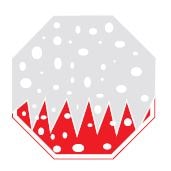
Explanation: The 'stop' sign is the only road sign that's octagonal. This is so that it can be recognised and obeyed even if it's obscured; for example, by snow.
239. You’re driving in the left-hand lane of a three-lane dual carriageway. As you approach a junction, you see this sign on a gantry. What should you do if you wish to go straight ahead?
- Straddle both the left-hand and middle lanes, as you're not sure which lane to use
- Move across to the right-hand lane, as this is the only one that goes ahead at the junction
- Continue in the left-hand lane, as all three lanes carry on through the junction
- Move across to the middle lane, as the left-hand lane leaves at the junction

Explanation: This sign tells you that all lanes continue through the junction. Traffic leaving at the junction does so by using a slip road. There will normally be countdown markers before the slip road.
240. You’re driving in the right-hand lane on a three-lane motorway. What should you do when you see this sign?
- Leave the motorway at the next exit
- Stop
- Move to the middle lane
- Move to the left-hand lane

Explanation: This sign on the overhead gantry will be accompanied by flashing amber lights. The arrow directs you to move into the next lane. There might not be any visible signs of a problem ahead, but there might be queuing traffic or another hazard that you can't yet see.
241. You’re driving in town and see these lights flashing. What hazard would you expect to see next?
- An opening bridge
- A school crossing patrol
- An ambulance station
- A level crossing with no barrier
Explanation: These lights warn that children may be crossing the road to a nearby school. Slow down so that you're ready to stop if necessary.
242. You’re driving in town and see these lights flashing. What hazard would you expect to see next?
- An opening bridge
- A school crossing patrol
- An ambulance station
- A level crossing with no barrier
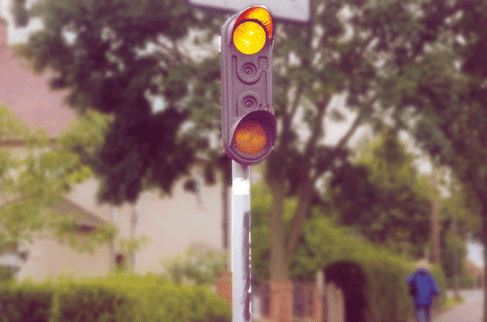
Explanation: These lights warn that children may be crossing the road to a nearby school. Slow down so that you're ready to stop if necessary.
243. You’re driving on a motorway that has chevrons painted on the carriageway. In good weather, at least how many chevrons should be visible between you and the next vehicle in your lane?
- One
- Two
- Three
- Four
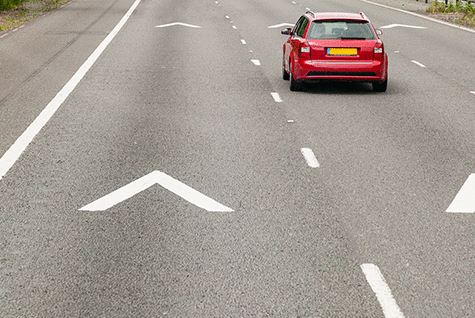
Explanation: Chevrons are painted on the road surface to help you to judge a safe following distance. In good weather, at least two chevrons should be visible on the road surface between your vehicle and the vehicle directly ahead in your lane. Where there are no chevrons, you should use the two-second rule.
244. You’re driving on a motorway. The traffic ahead is braking sharply because of an incident. How could you warn traffic behind?
- Switch on the hazard warning lights and leave them on
- Briefly use the hazard warning lights
- Switch on the headlights and leave them on
- Briefly use the rear fog lights
Explanation: While the car is in motion, hazard warning lights are only allowed to be used if you're travelling on a motorway or unrestricted dual carriageway and you want to warn traffic behind of a hazard ahead. Only use them for a short period of time - just long enough to ensure that your warning has been seen.
245. You’re driving on a motorway. What does it mean if the car ahead shows its hazard warning lights for a short time?
- There's a police speed check ahead
- The driver is going to change lanes
- The driver wants you to overtake
- Traffic ahead is slowing or stopping suddenly
Explanation: Hazard warning lights mustn't be switched on in normal driving. The exception is when driving on a motorway or unrestricted dual carriageway and there's a need to warn drivers behind of a hazard or obstruction ahead.
246. You’re driving on a motorway. What must you do if you see this signal above every lane?
- Stop and wait
- Slow down and watch for further signals
- Stop on the hard shoulder
- Leave at the next exit
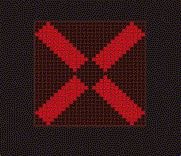
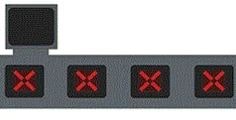
Explanation: Red flashing lights above every lane mean you mustn't go on any further. You'll also see a red cross illuminated. Stop and wait. Don't
- change lanes
- continue
- stop on the hard shoulder (unless in an emergency).
247. You’re driving on a motorway. What should you do if the overhead signs show a red cross with red flashing lights above your lane?
- Pull onto the hard shoulder
- Stop and wait for an instruction to proceed
- Move into another lane as soon as you can do so safely
- Continue in that lane and look for further information
Explanation: A red cross with flashing red lights above your lane shows that your lane is closed. You should move into another lane as soon as you can do so safely. If the signal shows above all lanes, you must stop and not go beyond the signal.
248. You’re driving on a motorway. What should you do if there’s a red cross with flashing red lights on the gantry above your lane?
- Move to another lane and stop
- Slow down to 50 mph
- Don't go beyond the signal in that lane
- Leave the motorway at the next exit
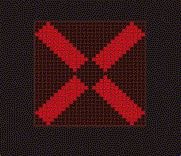
Explanation: The lane under a gantry signal showing a red cross with flashing red lights is closed to traffic. You shouldn't proceed past that point in that lane. Should other lanes be open, move to a different lane and proceed with care. If red signals are shown above all lanes, then all lanes are closed: you must stop and wait for the lights to change or until you're directed to move.
249. You’re driving on a road that has double solid white lines in the middle of the road. When may you cross these lines to overtake?
- To pass a queue of traffic at a junction
- To pass a road maintenance vehicle travelling at 10 mph or less
- To pass a vehicle towing a trailer
- To pass a car signalling to turn left ahead
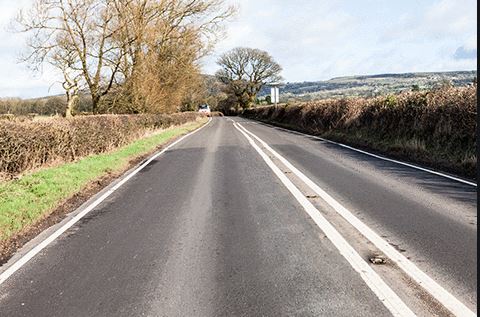
Explanation: If it's safe to do so, you may cross a solid white line to pass a road maintenance vehicle, pedal cycle or horse, if they're travelling at 10 mph (16 km/h) or less. When safe, you may also cross the solid line to enter a side road, access a property or pass a stationary vehicle.
250. You’re driving on a three-lane motorway. There are red reflective road studs to your left and white ones to your right. Which lane are you using?
- The hard shoulder
- The right-hand lane
- The middle lane
- The left-hand lane
Explanation: The colours of the reflective studs on the motorway, and their locations, are
- red - between the hard shoulder and the carriageway
- white - between the lanes
- amber - between the edge of the
carriageway and the central reservation
- green - along slip-road exits and entrances bright green/yellow - at roadworks and contraflow systems.
251. You’re driving on an urban clearway during its time of operation. Apart from breakdowns, when may you stop on this road?
- To set down and pick up passengers
- To ask for directions
- To load or unload goods
- To use a mobile telephone
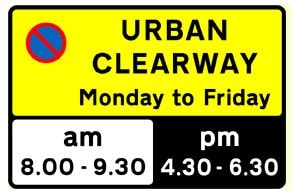
Explanation: A clearway is a section of road where no stopping is allowed on the main carriageway. However, a driver can stop on an urban clearway, during its times of operation, to set down or pick up passengers.
252. You’re driving over a level crossing. What should you do if the warning lights come on and a bell rings?
- Stop and reverse back to clear the crossing
- Stop immediately and use your hazard warning lights
- Keep going and clear the crossing
- Get everyone out of the vehicle immediately
Explanation: If the amber warning lights come on as you're approaching the crossing, you must stop unless it's unsafe to do so. Red flashing lights together with an audible signal mean you must stop. If the warning lights and alarm start as you're driving over the crossing, continue and clear the crossing; it would be dangerous to stop at that point.
253. You’re driving towards a level crossing. What would be the first warning of an approaching train?
- One half barrier coming down
- A steady amber light
- Twin flashing red lights
- Both half barriers coming down
Explanation: The steady amber light will be followed by twin flashing red lights, which mean you must stop. An alarm will also sound to alert you to the fact that a train is approaching.
254. You’re driving towards a zebra crossing. What should you do if pedestrians are waiting to cross?
- Use your headlights to indicate they can cross
- Wave at them to cross the road
- Give way to the elderly and infirm only
- Slow down and prepare to stop
Explanation: When approaching a zebra crossing, drivers should look out for pedestrians wanting to cross. If anyone is waiting, you should slow down and be ready to stop and let them cross.
255. You’re driving towards a zebra crossing. What should you do if you see a person in a wheelchair waiting to cross?
- Wave to the person to wait
- Be prepared to stop
- Continue on your way
- Wave to the person to cross
Explanation: As you would with an able-bodied person, you should prepare to slow down and stop. Don't wave them across, as other traffic may not stop.
256. You’re driving towards road works and you see this temporary speed-limit sign. When must you comply with the sign?
- At all times
- When the lanes are narrow
- During the hours of darkness
- During the working day
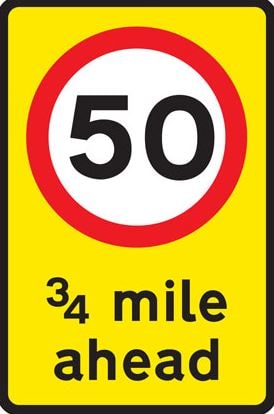
Explanation: A circular sign with a red border tells you what you mustn't do. If the circle contains a speed limit, you mustn't exceed the limit, whether the sign is temporary or not.
257. You’re giving a driving lesson in an unfamiliar town. What should you tell your pupil if you see this sign?
- Drive on; it doesn't apply to you
- Follow the park-and-ride signs
- Give way only to trams from the right
- Don't drive past this traffic sign
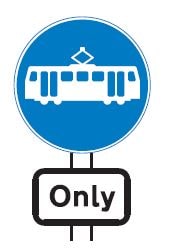
Explanation: This sign indicates a route for trams only. Other vehicles aren't allowed to use these routes. Drivers need to look ahead and plan - especially in an unfamiliar area.
258. You’re giving a lesson in a car fitted with automatic transmission. What should you tell the pupil to do whenever the vehicle is stationary?
- Apply the parking brake fully
- Keep their foot firmly on the accelerator
- Put the gear selector in the 'R' position
- Put the gear selector in the 'D' position
Explanation: Fully applying the parking brake whenever your vehicle is stationary is important with an automatic car. This will reduce the possibility of the car creeping forwards when it's in gear.
259. You’re going to drive a car that you haven’t driven before. What’s the most important consideration when you’re adjusting the seat?
- Make sure you can open the door while wearing the seat belt
- Make sure there's room for rear-seat passengers
- Make sure you can reach and operate the controls
- Make sure the head restraint doesn't obstruct the view in the mirror
Explanation: At the start of their training, a pupil needs to understand why the seating adjustment is important. They should familiarise themselves with all seat adjustment controls; without assistance, pupils should be able to move the seat into a position where they can reach all of the important controls comfortably.
260. You’re in the right-hand lane of a dual carriageway. What should you do when you see this sign?
- Move into a lane on your left immediately
- Wait to see which lane is moving faster
- Keep in the right-hand lane for as long as you can
- Move into a lane on your left in good time
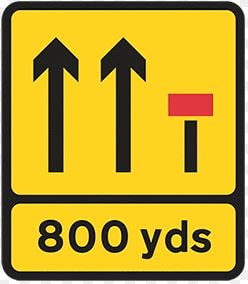
Explanation: Lane closures are normally found near roadworks. Use your mirrors and move into the correct lane for your vehicle in good time. Look out for additional signs and comply with them.
261. You’re looking for somewhere to park your vehicle. What should you do if the only spaces available are marked for disabled use?
- Double park in the aisle and switch on your hazard warning lights
- Park in these spaces because everywhere else is full
- Find somewhere else to park, unless you're a registered disabled driver
- Use these spaces because the disabled markings aren't enforceable
Explanation: You mustn't park in spaces designated or marked for specific users, such as registered disabled drivers (whose vehicle will display a blue disabled badge), or in places reserved for local residents.
262. You’re making a right turn. What could you do if you think your indicators might be difficult to see?
- Turn as quickly as you can
- Put the indicator on later
- Give an arm signal to emphasise the indicator
- Veer from side to side as you slow down
Explanation: You should always do your best to make other road users aware of your intentions. If you think your indicator might not be seen, or your intentions might not be clear, then giving an arm signal as well may be helpful.
263. You’re on a long downhill slope. What should you do to help control the speed of your vehicle?
- Select a lower gear
- Select neutral
- Apply the parking brake gently
- Turn off the engine
Explanation: Selecting a low gear when travelling downhill will help you to control your speed. The engine will assist the brakes and help prevent your vehicle from gathering speed.
264. You’re parking on the left, facing downhill. You apply the parking brake firmly. What further safety precautions should you take?
- Keep your wheels straight and select neutral
- Turn your wheels to the left and select reverse gear
- Turn your wheels to the right and select reverse gear
- Keep your wheels straight and select fifth gear
Explanation: Turning the wheels to the left will ensure that if the vehicle rolls forward, it will immediately contact the kerb. The use of reverse gear will help by using the resistance of the engine to prevent the vehicle from rolling forwards should the parking brake fail.
265. You’re testing your vehicle’s suspension. What does it mean if the vehicle continues to bounce when you test it?
- The shock absorbers are worn
- The steering is unstable
- The tyres are under-inflated
- The tyres are worn
Explanation: To test your suspension, press down sharply on the bodywork above each wheel and release it. If the vehicle bounces more than once, take it to be checked by a qualified mechanic. A good shock absorber will dampen the movement immediately.
266. You’re waiting at a level crossing. What must you do if a train has passed but the lights keep flashing?
- Carry on waiting
- Edge over the stop line and look for trains
- Phone the signal operator
- Park and investigate
Explanation: If the lights at a level crossing continue to flash after a train has passed, wait, as there might be another train coming. Time seems to pass slowly when you're held up in a queue. Be patient; there's a good safety reason why the barriers have remained down and the lights continue to flash.
267. You’re waiting at a level crossing. What should you do if the red warning lights continue to flash after a train has passed?
- Get out and investigate
- Drive across carefully
- Continue to wait
- Zigzag around the barriers
Explanation: At a level crossing, flashing red lights mean you must stop. If a train passes but the lights keep flashing, you must continue waiting. Another train will be coming.
268. You’re waiting at a pelican crossing. What should you do if pedestrians are halfway across when the lights change to green?
- Wait for them to finish crossing
- Drive on as soon as your way is clear
- Flash your headlights in case they've not heard you
- Rev your engine to make them hurry
Explanation: If the lights change to green at a pelican crossing, wait for any pedestrians to finish crossing. Allow them to cross the road in their own time, and don't try to hurry them by revving your engine.
269. You’re waiting at a railway level crossing. What should you do if the red lights keep flashing after a train has passed?
- Proceed with caution
- Alert drivers behind you
- Phone the signal operator
- Continue to wait
Explanation: You must always obey red flashing stop lights. If a train passes but the lights continue to flash, another train will be passing soon. Cross only when the lights go off and the barriers open.
270. You’ve driven through a ford. What should you do when you’re out of the water?
- Accelerate quickly
- Test your brakes
- Switch on your headlights
- Check your tyre pressures
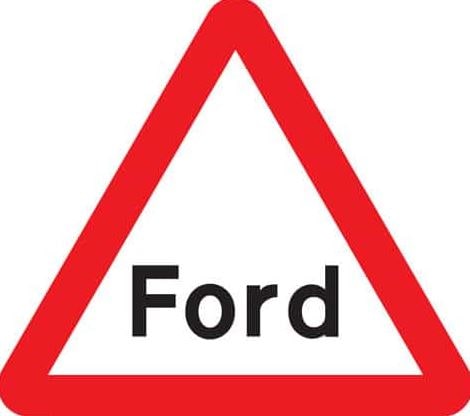
Explanation: When you've driven through a ford or flood, your brakes may be soaking wet. Water can reduce your brakes' efficiency, so check that they're working properly before you build up speed again. Lightly applying the brakes while driving slowly will help them to dry. Before you do this, remember to check your mirrors and consider what's behind you.
271. You’ve just driven through flood water. How should you dry out the brakes?
- Stop at the nearest garage and have the brakes looked at
- Stop and pump the brake pedal several times
- Drive at a normal speed until the brakes work properly
- Drive slowly and apply light pressure to the footbrake
Explanation: Before you test the brakes, don't forget to check for traffic behind. If it's safe, drive slowly and gently apply the brakes until they dry out and work properly again.
272. You’ve stopped at a pelican crossing. What should you do if the lights change to green while someone is crossing slowly in front of you?
- Drive behind the person
- Allow the person to cross
- Sound your horn
- Drive in front of the person
Explanation: At a pelican crossing, the green light means you may proceed as long as the crossing is clear. If someone hasn't finished crossing, be patient and wait for them.
www.firstbinghamdrivingschool.co.uk is a participant in the Amazon Services LLC Associates Program, an affiliate advertising program designed to provide a means for sites to earn advertising fees by advertising and linking to amazon.com. As an Amazon Associate, I earn from qualifying purchases. www.firstbinghamdrivingschool.co.uk participates in various other affiliate programs and we sometimes get commission through purchases made through our links.
